3
GRAIN MAINS FOR ALL APPETITES
Filling Your Plate with Whole Grain Goodness

It’s high time whole grains took their proper place on the plate! For far too long, they were viewed as just a way to round out a meal—but no more. We’ve packed this chapter with recipes that place grains front and center, and they are sure to hit the spot whether it’s as a light lunch or hearty dinner. With lots of international influences, as well as some American leanings, these recipes will satisfy cravings you might not even realize you have.

Split Pea and Rice Artichoke Mujaddara
Brussels Sprouts Rice and Groats Bake
Creamy Amaranth Polenta with Marinara
Creamy Pesto Asparagus Einkorn
Einkorn and Roasted Root Vegetable Gratin
Roasted Radish Freekeh Bowl with Mustard Miso Sauce
Apple Butter Einkorn Sloppy Joes
Roasted Cabbage Steaks with Chimichurri Sauce
Pepper Lovers’ Polenta with Raspberry BBQ Seitan
Saucy Peanut Eggplant and Freekeh
Hearty Sweet Potato and Sorghum Curry
Spelt and Bean Burritos
▸ GRAIN: SPELT
These burritos are fully loaded with energy and made even more wholesome with the addition of spelt berries. We find them to be flavor packed, yet tame enough spiciness-wise to enjoy for breakfast if you prefer savory foods first thing in the morning.
2 teaspoons (10 ml) grapeseed or olive oil
3/4 cup (120 g) minced yellow onion
1 bell pepper (any color), seeded and diced
1 small jalapeño pepper, seeded and minced
2 tablespoons (20 g) minced garlic
1 teaspoon smoked or regular paprika
1 teaspoon ground cumin
1 teaspoon mild to medium chili powder
1/2 teaspoon ground turmeric
1/2 teaspoon fine sea salt, to taste
1 cup (194 g) cooked spelt berries
1 can (15 ounces, or 425 g) black or kidney beans, drained and rinsed
Heaping 3/4 cup (210 g) Slightly Cheesy Cashew Sauce (page 166), plus extra for serving
6 tablespoons (6 g) minced fresh cilantro
6 (8-inch, or 20 cm) vegan flour tortillas
Nonstick cooking spray or oil spray
Favorite hot sauce, for serving
Preheat the oven to 400°F (200°C, or gas mark 6).
Place the oil, onion, peppers, garlic, paprika, cumin, chili powder, turmeric, and salt in a large skillet. Cook for 4 to 6 minutes on medium-high heat, stirring frequently, until the peppers and onion just soften while remaining slightly crisp. Stir spelt and beans into the mixture. Cook another 4 minutes. Add the sauce. Simmer another 2 minutes until thickened and fragrant.
Divide the mixture among the flour tortillas (1/2 cup, or 125 g, per tortilla), top with 1 tablespoon (1 g) cilantro, and roll burrito-style. Lightly coat each burrito with cooking spray. Bake for 15 minutes or until light golden brown. Serve immediately with extra cheesy sauce and hot sauce. (If you prefer your burritos unbaked, warm the flour tortillas in a heated pan on medium heat, about 30 seconds on each side to soften before use. Add heated filling to each tortilla, fold burrito style, and serve immediately.)
YIELD: 6 burritos
Polenta Topped Mexi-Beans
▸ GRAIN: POLENTA ▸ GLUTEN-FREE POTENTIAL ▸ SOY-FREE POTENTIAL
Rice and beans, the Mexican (and vegan) mainstay, just got an upgrade. Savory, lightly sauced beans nestle under a crispy polenta round, just waiting for the salsa and avocado to make the dish complete.
1 tablespoon (15 ml) olive oil
1/2 cup (80 g) minced onion
3 cloves garlic, minced
1 poblano pepper, roasted and peeled, (see Recipe Note), chopped
2 teaspoons (5 g) ground cumin
1 teaspoon smoked paprika
1/2 teaspoon dried oregano
1/2 teaspoon dried thyme
1/2 teaspoon chili powder, or to taste
1 can (15 ounces, or 425 g) pinto beans, drained and rinsed
2 tablespoons (34 g) tomato paste
2 tablespoons (30 ml) dry red wine, or additional broth
3 tablespoons (45 ml) vegetable broth, more if needed
Salt and pepper
1 teaspoon apple cider vinegar, optional
1 recipe Mom’s Polenta (page 28)
High heat neutral-flavored oil, for roasting the poblano and cooking the polenta
1/2 avocado, pitted, peeled, and sliced
Salsa, for serving
Heat the oil in large skillet over medium heat. Add the onion, garlic, poblano, cumin, paprika, oregano, thyme, and chili powder. Cook, stirring, for 3 to 4 minutes until fragrant. Add the beans, tomato paste, wine, and broth. Cook over low heat, stirring occasionally, for 15 minutes. If the mixture appears dry, add extra splashes of broth as needed. Season to taste with the salt and pepper. Add the vinegar, if desired.
Heat a thin layer of oil in a large skillet over medium-high heat. After lifting the polenta in the paper lining from the loaf pan, use a biscuit cutter to cut the polenta into two rounds. Pour a 1/4-inch (6 mm) layer of oil in a large skillet and heat over medium heat. Add the rounds. Do not move them until the bottoms are slightly browned, about 4 to 6 minutes. Moving them too soon can remove the crisp outer coating. Turn over the rounds and cook the second side until browned and crisp, 4 to 6 minutes.
To serve, divide the beans in half between the two plates using a biscuit cutter as a mold. Gently lift the mold and add a polenta round. Top with salsa and avocado.
YIELD: 2 servings
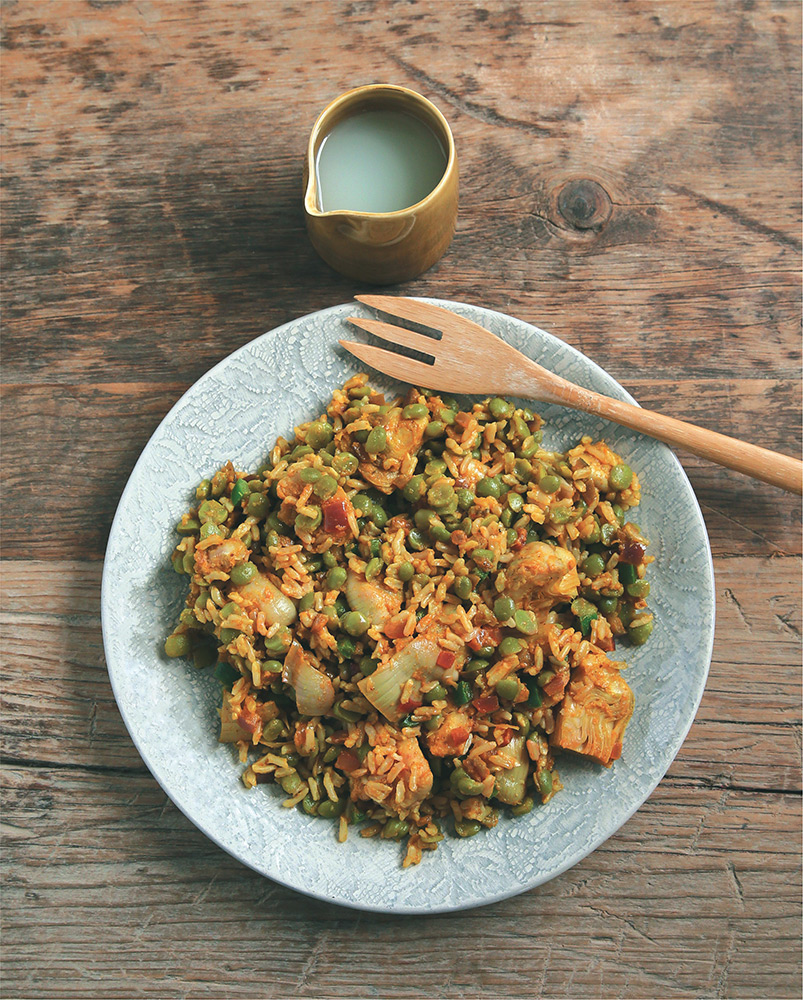
◁ Split Pea and Rice Artichoke Mujaddara
▸ GRAIN: BROWN RICE ▸ SOY-FREE POTENTIAL ▸ GLUTEN-FREE POTENTIAL
We did a version of mujaddara in The Great Vegan Protein Book, and we love it so much that we couldn’t resist whipping up a different one here. This time, we’re using split peas instead of lentils, mostly because we find split peas aren’t used in enough creative ways. Nothing against split pea soup, but they’re too good to be restricted to that role. Here, we’re combining them with long-grain brown rice. Jasmine is Celine’s favorite, but basmati is great too.
2/3 cup (130 g) dry green split peas, rinsed and picked through
2/3 cup (123 g) dry long-grain brown rice, rinsed and picked through
1 1/4 cups (295 ml) vegetable broth
1 tablespoon (15 ml) olive oil or melted coconut oil
1 medium red onion, diced
1 jalapeño pepper, seeded and minced
Scant 2 tablespoons (15 g) minced garlic
1 1/2 teaspoons packed, grated fresh ginger
8 ounces (227 g) chopped cooked artichoke hearts (jarred or canned)
1/2 teaspoon fine sea salt, to taste
1/2 teaspoon turmeric
1/2 teaspoon ground cumin
1/2 teaspoon ground coriander
1/2 teaspoon smoked paprika
Fresh cilantro or parsley leaves, to taste
Lemon wedges, to serve
Place peas in a pot, cover with an extra 2 inches (5 cm) of water, and bring to a boil. Lower the heat, partially cover with a lid, and simmer for about 30 minutes until the peas are tender. Drain, rinse, and set aside.
While the peas are cooking, place the rice in a wide, shallow pot. Cover with broth, stir to combine, and bring to a boil. Lower the heat, cover with a lid, and simmer until the rice is tender, about 30 to 35 minutes. Remove from the heat and leave covered for 10 minutes. Fluff with a fork.
While the rice is resting, in a large skillet add the oil, onion, pepper, garlic, and ginger. Cook on medium-high heat until softened, about 4 minutes, stirring occasionally. Add the artichokes, salt, turmeric, cumin, coriander, and paprika, stirring to combine. Cook for another 2 minutes. Turn off the heat. Gently fold the split peas and rice into the spices. Top with a handful of herbs and lemon wedges.
Leftovers taste even better and can be stored in an airtight container in the refrigerator for up to 4 days. Slowly reheat before serving.
YIELD: 4 servings
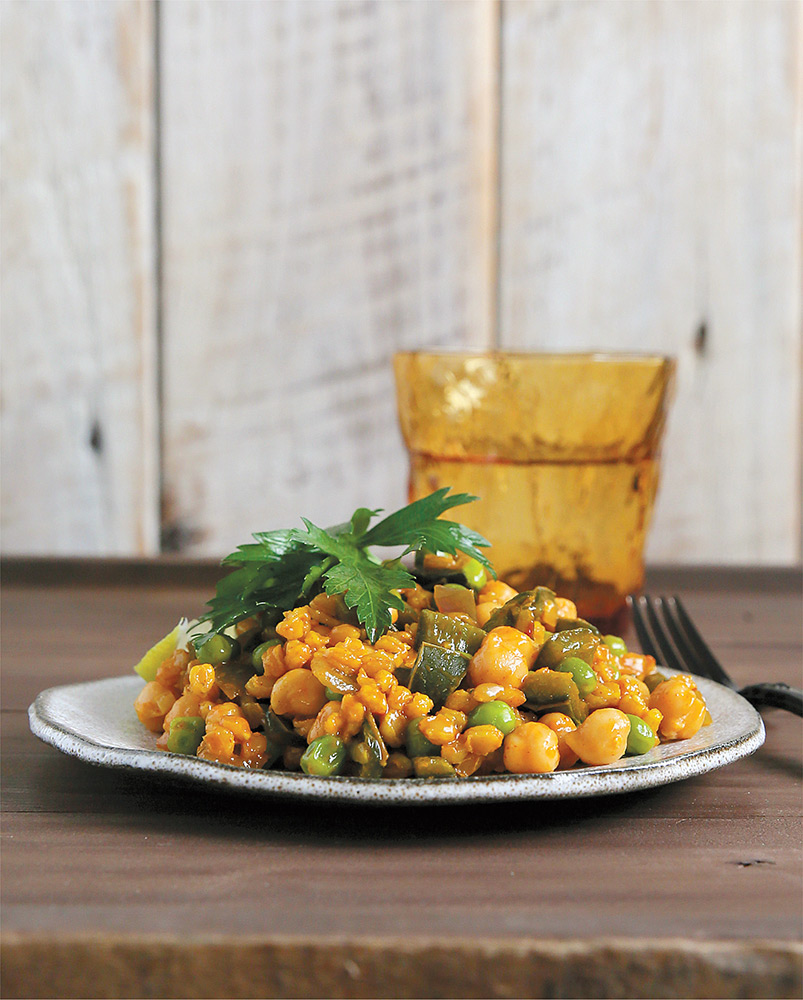
◁ Einkorn Paella
▸ GRAIN: EINKORN ▸ SOY-FREE POTENTIAL
Our delightfully simple paella is adorned with chickpeas, but you can also brown pieces of Pepper Grain Sausages (page 87) and add them on top. Einkorn can be replaced with hulled barley, rice, or any similar grain. Just be sure to precook your pick so that only 10 minutes of cooking time remain.
3/4 cup (144 g) dry einkorn, rinsed and drained
4 cups (940 ml) vegetable broth
1 tablespoon (15 ml) olive oil
2 poblanos or bell peppers (any color), seeded and diced
3/4 cup (120 g) diced red onion
1 1/2 tablespoons (15 g) minced garlic
1 1/2 teaspoons smoked paprika
1/2 teaspoon (quite loose, not packed) saffron threads
1/2 teaspoon coarse kosher salt, to taste
1/2 teaspoon dried oregano leaves (not powder, use 1/4 teaspoon if powder)
1 sprig fresh thyme
1 cup (134 g) frozen green peas
1 1/2 cups (256 g) cooked chickpeas
Splash of dry vegan white wine, optional
Ground black pepper, to taste
1/4 cup (15 g) chopped fresh flat-leaf parsley
Lemon wedges, for garnish
Combine the einkorn with the broth in a large pot. Bring to a boil, lower the heat to medium and precook for 20 minutes. Carefully drain the einkorn by placing a fine-mesh sieve on top of a glass bowl or measuring cup to save the cooking liquid.
While the einkorn cooks, place the oil in a large skillet along with the poblanos and onion. Sauté on medium-high heat for 2 minutes. Add the garlic and paprika. Sauté for another 2 minutes until slightly softened and lightly browned. Add saffron, salt, oregano, thyme, 1 cup (235 ml) of the reserved cooking liquid, and cooked einkorn to the poblanos, gently folding to combine. Bring to a gentle boil, lower the heat, and cover with a lid. Simmer until the einkorn is al dente, about 10 minutes, stirring occasionally. Add extra cooking liquid, if needed. Stir the peas and chickpeas into the einkorn, add a splash of wine, and cook uncovered for another 5 minutes, stirring occasionally. Discard the thyme. Adjust seasoning, if needed. Top each serving with parsley and a wedge of lemon.
YIELD: 4 servings
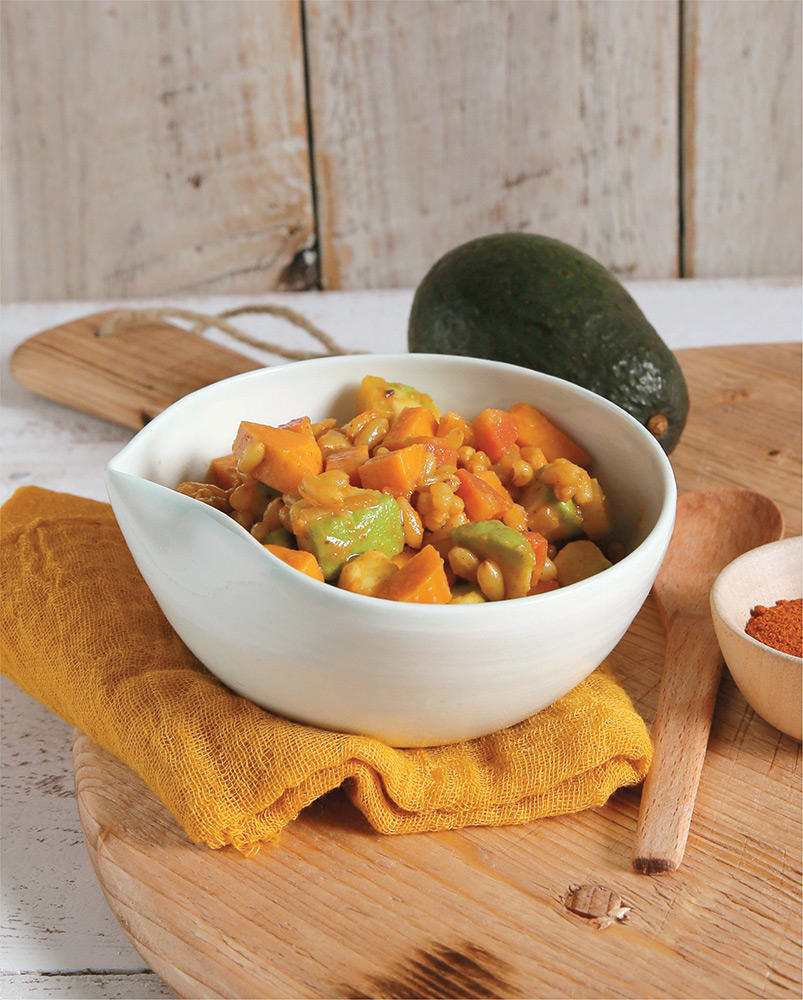
◁ Berbere Kamut with Avocado
▸ GRAIN: KAMUT ▸ SOY-FREE POTENTIAL
Berbere is an Ethiopian spice mix with varying levels of heat, depending on the brand purchased. It’s best to add it to taste so that you don’t end up with too-salty or too-spicy results. Add extra berbere at the end, if needed. We love it here in this colorful and comforting kamut dish where the avocado rounds things out with its creamy richness. If kamut isn’t handy, use any grain with a similar texture, such as wheat berries, whole freekeh, or spelt, adjusting cooking time accordingly (see Grain Chart, pages 15–16).
1 cup (184 g) dry kamut, rinsed and drained
4 cups (940 ml) vegetable broth
1 tablespoon (15 ml) grapeseed or olive oil
1/2 teaspoon coarse kosher salt, more to taste
1 generous cup (130 g) chopped carrot (about 2 carrots)
2 medium sweet potatoes, peeled and chopped
Generous 1/2 cup (90 g) chopped yellow onion
2 large cloves garlic, minced
2 to 2 1/2 teaspoons (6 to 7.5 g) berbere spice, to taste
1/2 teaspoon ground cumin
1 tablespoon (17 g) organic tomato paste
2 large avocados (or 1 small avocado per serving), pitted, peeled, and chopped
Combine kamut with broth in a large pot. Bring to a boil, cover, and simmer until cooked al dente, about 45 to 60 minutes. Drain carefully in a fine-mesh sieve placed on top of a glass measuring cup or bowl to reserve the extra broth. Set aside.
Place the oil, salt, and carrots in a skillet fitted with a lid. Sauté for 1 minute, cover with the lid and cook for 4 minutes. Add the sweet potato, onion, garlic, spice mix to taste, cumin, and tomato paste, stirring to combine, and sauté 2 minutes. Add reserved broth as needed, 1 tablespoon (15 ml) at a time. Cover with the lid. Simmer 15 minutes or until the carrots and potatoes soften but aren’t fully tender. Keep adding broth as needed. Add the cooked kamut. Simmer covered for another 10 to 15 minutes until slightly saucy and the veggies are perfectly tender but not mushy. Be sure to add reserved broth as needed. (We needed 1/2 cup plus 2 tablespoons, or 150 ml, in all.)
Let stand covered 15 minutes before serving. Adjust seasoning, if needed. Add chopped avocado on each portion and serve immediately.
YIELD: 4 to 6 servings
Brussels Sprouts Rice and Groats Bake
▸ GRAINS: BLACK RICE AND OAT GROATS ▸ GLUTEN-FREE POTENTIAL
This bake has turned a couple of brussels sprouts haters into new aficionados. Victory! We recommend cooking the oats and rice separately so that the purpleness the black rice releases while cooking doesn’t alter the color of the oats. Use wild rice if black rice isn’t available, adjusting cooking time accordingly (see Grain Chart, pages 15–16).
2/3 cup (123 g) dry oat groats, rinsed, cooked to al dente and cooled
1/2 cup (90 g) dry black rice, rinsed, cooked to al dente, and cooled
1 tablespoon (15 ml) grapeseed or olive oil
1/2 cup plus 1 tablespoon (90 g) chopped shallot
10 ounces (283 g) trimmed brussels sprouts, shaved to 1/8-inch (3 mm) thickness
3 cloves garlic, minced
2 tablespoons (30 ml) mirin
1 tablespoon (15 ml) ume plum vinegar
1 1/4 cups (295 ml) water, divided
1 cup (130 g) chopped carrots (yellow or white is best)
2 teaspoons (5 g) Broth Powder (page 167)
1 cup (240 g) Basic Cashew Cream (page 166)
1 tablespoon (8 g) nutritional yeast
2 teaspoons (10 ml) fresh lemon juice
1 tablespoon (18 g) white miso
1 teaspoon sriracha, to taste
1 tablespoon (5 g) minced scallion
In a skillet, place the oil and shallot and sauté on medium-high heat until translucent, about 2 minutes. Add the brussels sprouts and sauté for another 5 minutes until lightly browned. Add the garlic, mirin, vinegar, and 1/4 cup (60 ml) water (less if sprouts are shaved thinner than 1/8 inch [3 mm], add as needed). Cover with a lid, and simmer until tender, about 5 minutes. Stir the cooled oats and rice into the sprouts.
Preheat the oven to 375°F (190°C, or gas mark 5). Place the sprouts mixture at the bottom of an 10 × 8-inch (25 × 20 cm) oval baking dish.
In the meantime, prepare the carrots by adding them to the remaining 1 cup (235 ml) water combined with broth powder. (You can replace this with vegetable broth.) Bring to a boil, then lower the heat to medium. Cook until fork-tender, about 12 minutes, and drain. Transfer to a food processor along with cashew cream, nutritional yeast, lemon juice, miso, and sriracha. Process until completely smooth. Pulse the scallion to combine. Evenly spread the cream mixture on top of sprouts mixture. Bake for 30 minutes until light golden brown on top. Let stand 10 minutes before serving.
YIELD: 6 to 8 servings
Butternut Bean Kamut-sotto
▸ GRAIN: KAMUT ▸ SOY-FREE POTENTIAL
It would be impossible to pick only one favorite whole grain out of all our new favorites, but kamut is a strong contender. We’ve paired it with leftover roasted butternut squash in this “risotto,” and were quite impressed with the fancy outcome and fabulous flavors. We hope you will be, too. If kamut isn’t handy, use any grain with a similar texture, such as wheat berries, whole freekeh, or spelt, adjusting cooking time accordingly (see Grain Chart, pages 15–16).
1 cup (184 g) dry kamut, rinsed and drained
4 cups (940 ml) water, divided
1 tablespoon plus 1 teaspoon (11 g) Broth Powder (page 167), divided
1 1/2 cups (290 g) roasted bite-size butternut squash cubes (see Recipe Note)
1/2 cup (120 g) chipotle dressing (page 147)
1/2 teaspoon coarse kosher salt, to taste
1 1/2 teaspoons grapeseed or olive oil
1/2 cup plus 2 tablespoons (100 g) chopped shallot
1 tablespoon (10 g) minced garlic
1 teaspoon smoked paprika
1/2 teaspoon ground cumin
1 can (15 ounces, or 425 g) white, black, or kidney beans, drained and rinsed
Combine kamut with 3 cups (705 ml) water and 1 tablespoon (8 g) broth powder in a large pot, and bring to a boil. Cover, and simmer until cooked al dente, about 45 to 60 minutes. Drain, if needed, and set aside.
In a blender, combine the remaining 1 cup (235 ml) water, remaining teaspoon broth powder, roasted squash, chipotle dressing, and salt. Blend until perfectly smooth.
In a skillet, combine the oil and shallot. Heat on medium-high heat and cook until fragrant and the shallot is translucent, about 4 minutes. Add the garlic, paprika, cumin, beans, and cooked kamut. Cook for another 2 minutes. Stir the blended squash sauce into the mixture, cover with a lid, and simmer for 10 to 15 minutes until heated through. Serve. Leftovers can be stored in an airtight container in the refrigerator for up to 3 days. Slowly reheat before serving.
YIELD: 4 servings
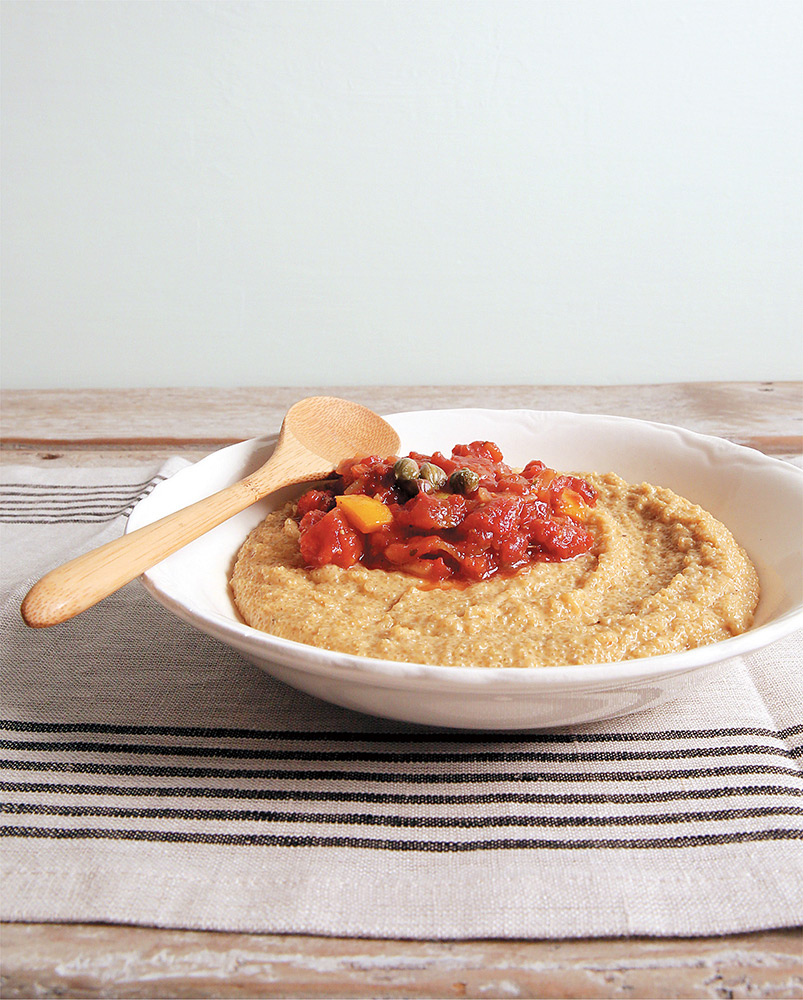
◁ Creamy Amaranth Polenta with Marinara
▸ GRAIN: AMARANTH ▸ GLUTEN-FREE POTENTIAL
There’s no limit to how many bowls of creamy amaranth polenta that Celine and her husband could eat, if they let themselves. Self-control is hard! Note that if your herbes de Provence mix contains lavender or fennel, you must steer clear (the flavor combo wouldn’t be great) and use Italian seasoning instead.
FOR THE MARINARA:
1 1/2 teaspoons grapeseed or olive oil
1/4 cup plus 2 tablespoons (60 g) minced shallot
2 cloves garlic, minced
1 yellow (or other color) bell pepper, seeded and diced
Salt and pepper
Red pepper flakes, to taste, optional
1 teaspoon herbes de Provence or Italian seasoning
2 cups plus 2 tablespoons (545 g) chopped tomatoes with juice (such as Pomi)
1 tablespoon (7 g) minced soft sun-dried tomatoes
1 1/2 teaspoons capers, minced, plus extra for garnish
FOR THE POLENTA:
1 cup (180 g) dry amaranth
2 scant cups (460 ml) no- or low-salt vegetable broth or water
1/2 cup (60 g) chopped carrot, cooked until tender
1/4 cup plus 2 tablespoons (90 g) Basic Cashew Cream (page 166)
1 tablespoon (8 g) nutritional yeast
2 teaspoons (12 g) white miso
2 teaspoons (10 ml) fresh lemon juice
1 teaspoon Broth Powder (page 167)
To make the marinara: Place the oil, shallot, garlic, and bell pepper in a skillet. Cook on medium-high heat and stir occasionally until the pepper softens, about 4 minutes. Add salt and pepper, herbes de Provence, tomatoes, and sun-dried tomatoes. Lower the heat to medium and simmer uncovered for 10 minutes. Stir the capers into the sauce. Set aside.
To make the polenta: Place the amaranth and vegetable broth (or water) in a large pot. Bring to a boil. Lower the heat to medium low, cover with a lid, and simmer for 15 minutes. Remove the lid occasionally to stir the amaranth, and adjust the heat, if needed, to prevent scorching.
In the meantime, combine the remaining ingredients in a small blender, or use a handheld blender, and blend until perfectly smooth. Fold the sauce into the amaranth after the 15 minutes cooking time. Continue to simmer covered for another 5 minutes or until thickened like polenta, or to taste. Scoop out the polenta and serve with marinara. Leftover marinara can be stored in an airtight container in the refrigerator for up to 4 days.
YIELD: 3 to 4 side-dish servings, or 2 main-dish servings, and 3 cups (about 690 g) marinara
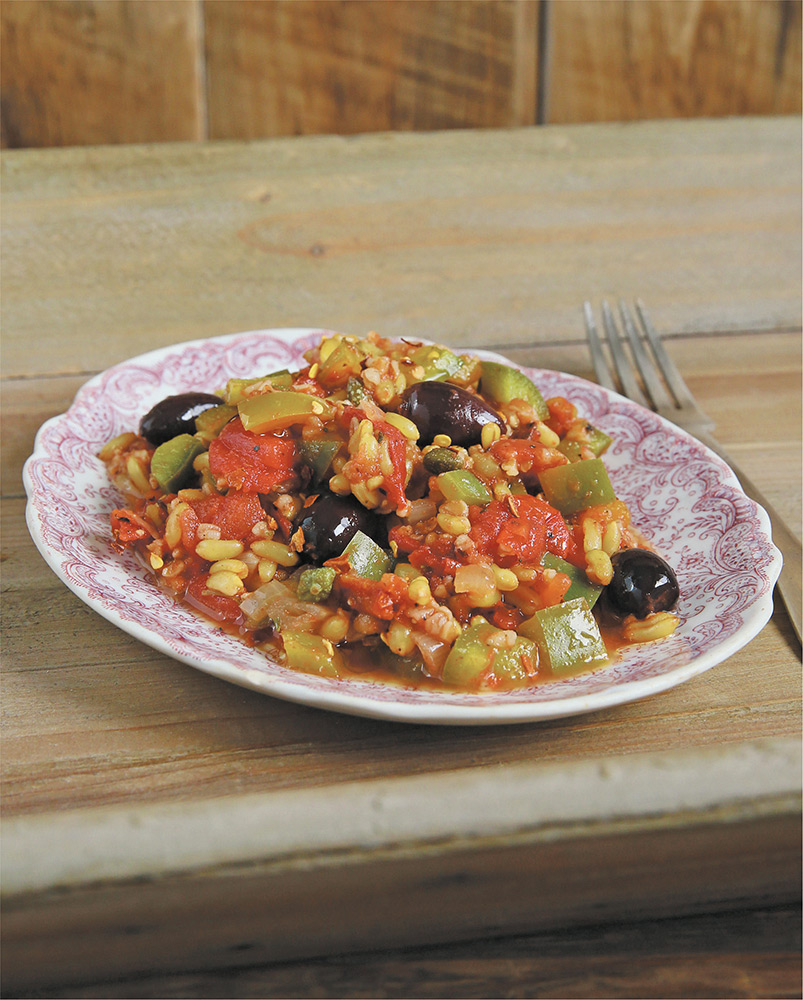
◁ Kamut Puttanesca
▸ GRAINS: KAMUT AND CRACKED WHEAT ▸ SOY-FREE POTENTIAL
Puttanesca is a tomato-based sauce with bold flavors. We’ve taken a less conventional road by using bell pepper in the preparation and a combination of whole grains to stand in for traditional pasta. Kamut tends to absorb the sauce a little less efficiently than pasta, that’s why we’ve combined it with cracked wheat to soak up the flavor and thicken the sauce. You can substitute whole freekeh, spelt berries, triticale berries, or wheat berries for kamut, adjusting cooking time accordingly (see Grain Chart, pages 15–16).
3/4 cup (138 g) dry kamut, rinsed and drained
3 cups (705 ml) vegetable broth
1 tablespoon (15 ml) olive oil
1 bell pepper (any color), trimmed and chopped
3 1/2 tablespoons (35 g) chopped shallot
1 tablespoon (10 g) minced garlic
1 tablespoon (7 g) minced soft sun-dried tomatoes (not packed in oil)
1 tablespoon (9 g) capers (a little brine is acceptable)
10 kalamata olives, or a medley, pitted and chopped
1/4 to 1/2 teaspoon red pepper flakes, to taste
Pinch dried basil (see Recipe Note)
1 can (15 ounces, or 425 g) fire-roasted diced tomatoes with juice
3/4 cup (180 g) cooked cracked wheat or bulgur
Salt and pepper
Combine kamut with broth in a large pot and bring to a boil. Cover and simmer until cooked al dente, about 45 to 60 minutes. Drain and set aside.
Place the oil, bell pepper, shallot, and garlic in a large skillet. Sauté on medium heat until the pepper just starts to soften, about 3 minutes. Add the sun-dried tomatoes, capers, olives, red pepper flakes, and basil, stirring to combine and cooking for 1 minute. Add the diced tomatoes, stir to combine, and cover with a lid. Lower the heat and simmer for 15 minutes. Add the cooked kamut and cracked wheat, stirring to combine. Cover with the lid again. Simmer for another 5 minutes until heated through and to let the flavors meld. Adjust the seasoning, if needed. Serve as is, or with baked tempeh or tofu.
YIELD: 4 servings
Chickpea Millet Curry
▸ GRAIN: MILLET ▸ SOY-FREE POTENTIAL ▸ QUICK AND EASY ▸ GLUTEN-FREE POTENTIAL
We love to come home to a ready-in-no-time dinner, when all we crave is healthy, filling comfort food of the whole-grain variety. This one definitely hits the spot! Millet can be replaced with any cooked cereal you love the most.
1 teaspoon melted coconut oil or grapeseed oil
Generous 1/4 cup (30 g) chopped scallion
1/2 to 1 whole jalapeño pepper, seeded and minced, to taste
2 cloves garlic, minced
2 teaspoons (4 g) grated fresh ginger
2 teaspoons (4 g) mild to medium curry powder
1/2 teaspoon ground cumin
1 bell pepper (any color), seeded and diced
1 1/2 cups (260 g) cooked millet
1 cup (164 g) cooked chickpeas
1/2 teaspoon fine sea salt, to taste
1/2 cup (120 ml) canned coconut milk
Water or vegetable broth, as needed
Chopped fresh cilantro or parsley, to taste
Wedges of lime, for garnish
Place the oil, scallion, jalapeño, garlic, ginger, curry, cumin, and bell pepper in a large skillet. Sauté on medium-high heat for about 6 minutes until the bell pepper softens. Add a drizzle of water if the veggies stick to the skillet and adjust the heat. Add the millet, chickpeas, and salt to taste. Cook on medium heat for 2 minutes. Add the milk, and simmer for 4 minutes. Add extra vegetable broth or water if the curry is too thick for your taste. Cook just to heat through. Serve immediately with fresh herbs and wedges of lime.
YIELD: 2 to 3 servings
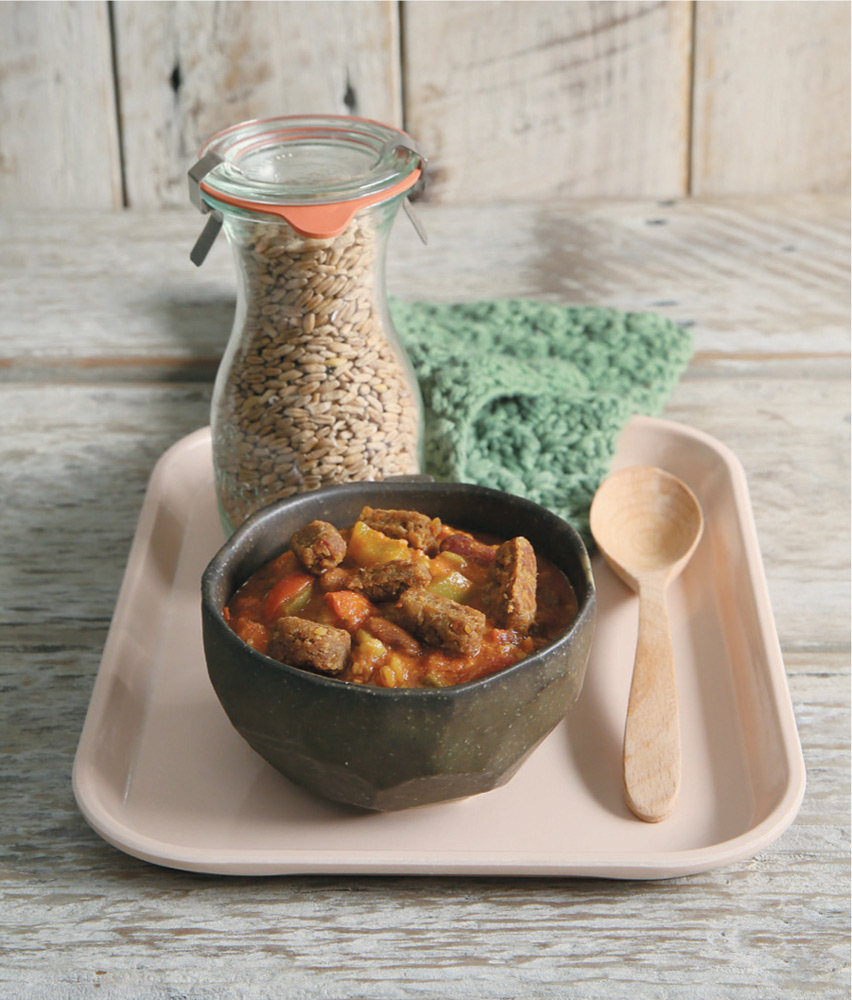
◁ Spelt Chili
▸ GRAIN: SPELT ▸ SOY-FREE POTENTIAL
Nothing beats a big bowl of protein-packed and flavor-filled vegan chili on colder days. As an added bonus, the spelt berries make it even heartier! If spelt isn’t available, cooked kamut, wheat berries, or any grain similar in texture, and sturdy enough to endure extra cooking time will be perfect here. If you’re looking for a mega boost of protein, brown some chopped pieces of your favorite seitan and add it on top. Homemade guacamole would be fantastic as well.
1/2 ounce (14 g) sliced dried shiitake or other mushrooms, rinsed to remove grit
1 cup (235 ml) water
1 tablespoon (15 ml) grapeseed or olive oil
1/2 cup plus 2 tablespoons (100 g) chopped shallot or red onion
4 cloves garlic, minced
7 ounces (200 g) mini heirloom tomatoes, halved or quartered depending on size (or 1 cup, or 240 g, canned fire-roasted diced tomatoes)
2 small bell peppers, seeded and diced (any color)
1 small jalapeño pepper, seeded and minced
2 tablespoons (33 g) tomato paste
2 tablespoons (15 g) mild to medium chili powder
2 teaspoons (5 g) ground cumin
1/2 teaspoon fine sea salt, to taste
1/4 cup (30 g) nutritional yeast
1 tablespoon (8 g) Broth Powder (page 167)
1 can (15 ounces, or 420 g) tomato sauce (reserve the can)
1 1/3 cups (253 g) cooked spelt berries
1 1/2 cups (257 g) cooked black beans
Place the mushrooms in a medium bowl. Add the water on top, and press on the mushrooms to make sure they absorb the liquid. Soak for 5 minutes. Gently squeeze the liquid out of the mushrooms and set aside. Mince the mushrooms and set aside.
In a large-size pot, place the oil, shallot, garlic, tomatoes, and all peppers. Heat over medium heat and sauté for 4 to 6 minutes until the vegetables just start to soften. Stir occasionally. Add the tomato paste, chili powder, cumin, and salt. Cook for 1 minute. Add the mushrooms, nutritional yeast, broth powder, and tomato sauce. Pour the reserved mushroom liquid in the empty tomato sauce can. Add enough filtered water to reach the top edge of the can. Pour into the pot. Bring to a gentle boil, cover with a lid. Lower the heat and simmer for 15 minutes. Add the cooked spelt and beans, and simmer another 10 to 15 minutes until thickened to your liking. Reheated leftovers taste even better, as is so often the case with such dishes.
YIELD: 6 servings
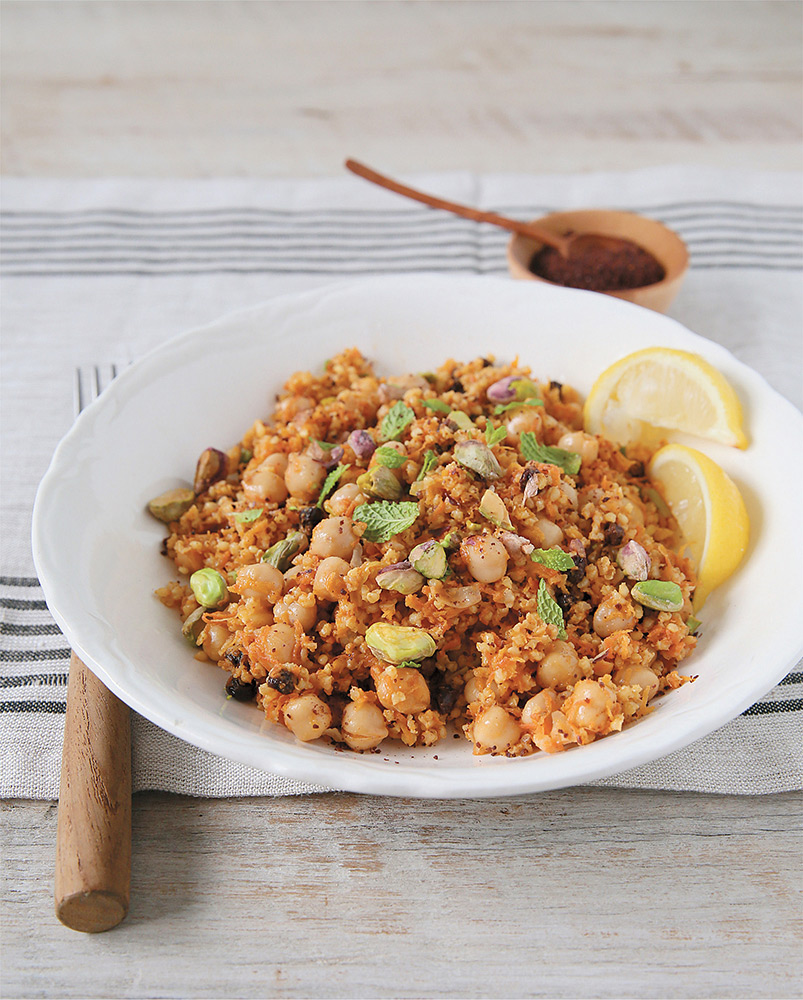
◁ Ras el Hanout Millet
▸ GRAIN: MILLET ▸ SOY-FREE POTENTIAL ▸ QUICK AND EASY ▸ GLUTEN-FREE POTENTIAL
Ras el hanout is a rich, Moroccan spice blend composed of ingredients such as coriander, turmeric, cardamom, and more. It can be purchased online or at well-stocked or international markets. We love it in this beautifully flavored, pilaflike dish that proves once again that millet should be placed in the spotlight more often. One of our testers (Liz) served it with a lightly dressed red cabbage salad, and we can concur that it’s a mighty fine pairing.
1/2 cup (110 g) dry millet, rinsed and drained
1 cup (235 ml) vegetable broth
1 1/2 cups (246 g) cooked chickpeas
1/4 cup (40 g) golden raisins (not packed) or (36 g) dried black currants
1 tablespoon (15 ml) toasted sesame oil
1 1/4 cups (140 g) finely grated carrot (about 2 medium carrots)
6 tablespoons (35 g) chopped scallion (white and green parts)
1 large clove garlic, grated or pressed
1 1/2 teaspoons ras el hanout
1/4 teaspoon red pepper flakes, to taste (optional)
1/2 teaspoon coarse kosher salt, to taste
Sumac, for garnish (or freshly grated zest from 1 large organic lemon)
Fresh cilantro, mint, or parsley leaves, for garnish
Chopped or whole pistachios, for garnish, optional
For even better results, take a moment to toast the millet in a skillet (page 8). Combine the millet and broth in a large skillet. Bring to a boil, lower the heat, cover with a lid and simmer until the liquid is absorbed, about 15 minutes. Remove from the heat and let stand 2 minutes. Fluff with a fork and set aside.
While the millet is cooking, combine the chickpeas, raisins, oil, carrot, scallion, garlic, ras el hanout, red pepper flakes, and salt in another large skillet.
Sauté on medium-high heat, stirring often, until the scallion soften slightly and the mixture is fragrant, about 5 minutes. Gently fold the millet into the chickpeas. Cook another 2 minutes, stirring occasionally.
This dish can be served immediately or left to stand at room temperature for 30 minutes before serving. Right before serving, garnish each portion with a pinch of sumac (or lemon zest), fresh herb of choice, and pistachios, if using.
YIELD: 4 servings
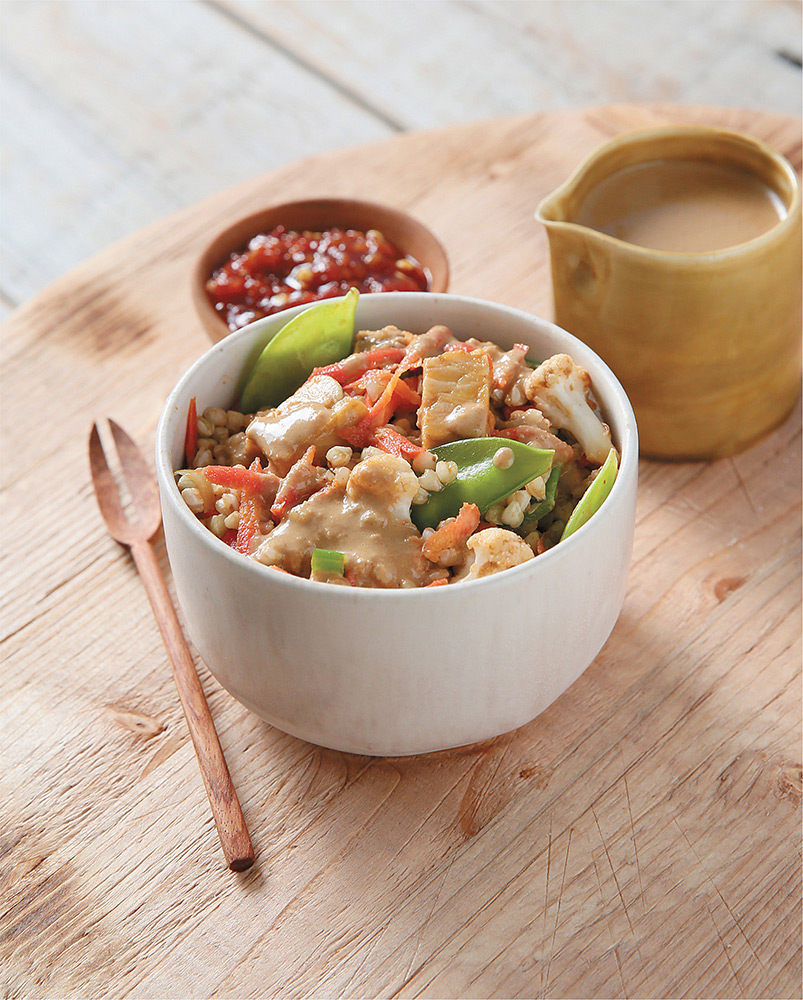
◁ Tempeh Buckwheat Bowl
▸ GRAIN: BUCKWHEAT ▸ GLUTEN-FREE POTENTIAL
We’ve combined some of our favorite Eastern flavors to create a light peanut sauce, and it plays very well with the protein-dense tempeh and vegetables. The peanut sauce is light, but layered, making this one a pleaser!
PEANUTTY SAUCE:
1 teaspoon neutral-flavored oil
1/4 cup (40 g) chopped onion
2 cloves garlic, minced
1/2 teaspoon minced fresh ginger
1 teaspoon ground cumin
1/2 teaspoon ground coriander
1/2 teaspoon five-spice powder
2/3 cup (160 ml) vegetable broth
2 tablespoons (32 g) smooth peanut butter
1 tablespoon (15 ml) seasoned rice vinegar
1 tablespoon (15 ml) tamari
1 to 2 teaspoons (5 to 10 g) sambal oelek
Salt and pepper
TEMPEH AND BUCKWHEAT:
2 tablespoons (30 ml) high heat neutral-flavored oil
8 ounces (227 g) tempeh, cut into 1/2-inch (1.3 cm) pieces (See Recipe Note)
1 cup (100 g) small cauliflower florets
2 teaspoons (5 g) ground cumin
1 teaspoon five-spice powder
3/4 cup (135 g) dry buckwheat groats, cooked, rinsed in cold water, and cooled
1/3 cup (30 g) (1-inch, or 2.5 cm) pieces snow peas
1/4 cup (25 g) chopped scallion
1 carrot, shredded
Salt and pepper
To make the peanutty sauce: Heat the oil in a small skillet over medium heat. Add the onion, garlic, and ginger. Cook, stirring occasionally, for 5 minutes until fragrant. Add the cumin, coriander, and five-spice powder, and cook 2 minutes longer. Add the broth, peanut butter, vinegar, tamari, and sambal oelek. Stir occasionally and bring to a boil then remove from the heat. Transfer to a small high-powered blender and process until smooth. Pour back into the skillet but do not place on the heat.
To make the tempeh and buckwheat: Heat the oil in large skillet over medium heat. Add the tempeh and cauliflower. Cook, stirring occasionally, for 5 to 7 minutes until the tempeh is browned. Add the cumin and five-spice powder. Cook for 2 minutes. Add the buckwheat, snow peas, scallion, and carrot. Cook, for 5 minutes, stirring frequently, until heated throughout and combined. Season to taste with salt and pepper.
Reheat the sauce over low heat, if necessary. Season to taste with salt and pepper. Divide the tempeh and buckwheat mixture evenly between 4 bowls. Drizzle evenly with the sauce.
YIELD: 4 servings, scant 1 cup sauce (200 g)
Creamy Pesto Asparagus Einkorn
▸ GRAIN: EINKORN ▸ SOY-FREE POTENTIAL
We’re suckers for anything that contains homemade pesto or fresh asparagus, so coming up with a dish that would highlight one of our new favorite whole grains (einkorn), and contain both the aforementioned, felt more like a vacation than work. Hulled barley or brown rice would be good alternatives here if einkorn plays hard to get. We must warn you that this is a dish best served fresh, as any grain will continue to absorb the pesto once refrigerated. If you have leftovers be sure to add a little extra pesto upon reheating.
3/4 cup (144 g) dry einkorn, rinsed and drained
1 1/2 cups (355 ml) vegetable broth
12 ounces (340 g) trimmed thin green asparagus, roasted or steamed (see Recipe Note)
1/2 cup (65 g) thinly sliced red onion
1/4 cup (60 g) Basic Cashew Cream (page 166)
1/4 cup (60 g) pesto (page 105) or other favorite vegan pesto, more to taste
Salt and pepper
Chopped fresh parsley, for garnish
Place the einkorn and broth in a medium saucepan. Bring to a boil. Lower the heat, cover with a lid, and simmer until al dente, 30 to 35 minutes. While the einkorn is cooking, chop the prepared asparagus into 1-inch (2.5 cm) pieces and add to a large skillet. Fold the cashew cream and pesto into the asparagus. During the last 5 minutes of cooking time for the einkorn, add the onion to the boiling water to soften. Drain the einkorn. Stir the einkorn into the asparagus, adjust seasoning to taste, and simmer covered for another 5 minutes. For extra flavor and creaminess, add more pesto to taste. Garnish each serving with parsley.
YIELD: 4 servings
Einkorn and Roasted Root Vegetable Gratin
▸ GRAIN: EINKORN
It’s so easy to fall in love with einkorn’s fantastic texture and mildly nutty flavor in this colorful gratin, but einkorn can be a little costly and occasionally hard to find. The more affordable doppelganger we recommend here is cooked hulled barley or medium- or long-grain brown rice. Be sure to follow the cooking instructions specific to the alternative grain you pick!
3/4 cup (144 g) dry einkorn, rinsed and drained
1 1/2 cups (355 ml) vegetable broth
3 medium turnips, trimmed and peeled, cut into 3/4-inch (2 cm) cubes
3 medium yellow carrots, trimmed and peeled, cut into 1-inch (2.5 cm) pieces, halved lengthwise if thick
1 ounce (28 g, about 5 large) peeled cloves garlic, left whole
2.8 ounces (80 g, about 1 medium to large) peeled and trimmed shallot, quartered
1 tablespoon plus 2 teaspoons (25 ml) grapeseed or olive oil, divided
3/4 teaspoon coarse kosher salt, divided
3/4 teaspoon smoked paprika, divided
1 tablespoon (8 g) Broth Powder (page 167), divided
3 medium red beets, trimmed and peeled, cut into 3/4-inch (1.9 cm) cubes
1 1/4 cups (303 g) Slightly Cheesy Cashew Sauce (page 166, made with a pinch of smoked paprika), prepared and cooked to thicken slightly
Place the einkorn and broth in a medium saucepan. Bring to a boil. Lower the heat, cover with a lid, and simmer until al dente or to taste, 30 to 35 minutes. Set aside.
Preheat the oven to 400°F (200°C, or gas mark 6). Have two 8-inch (20 cm) baking dishes ready. (You’re roasting separately so that the beets don’t stain the other vegetables.)
In one of the dishes, combine turnips, carrots, garlic, shallot, along with 1 tablespoon (15 ml) oil, 1/2 teaspoon each salt and paprika, and 2 teaspoons (5 g) broth powder. In the second dish, combine beets, remaining 2 teaspoons (10 ml) oil, 1/4 teaspoon each salt and paprika, and 1 teaspoon broth powder. Bake for 40 minutes or until the vegetables are just fork tender, stirring occasionally. Remove from oven. Lower the heat to 350°F (180°C, or gas mark 4).
Place cooked einkorn at the bottom of an 8 × 10-inch (20 × 25 cm) oval baking dish. Chop the shallot and garlic once cool enough to handle. Place the vegetables evenly on top of einkorn. Pour sauce evenly on top. Bake for 15 minutes. Let stand 10 minutes before serving.
YIELD: 6 servings
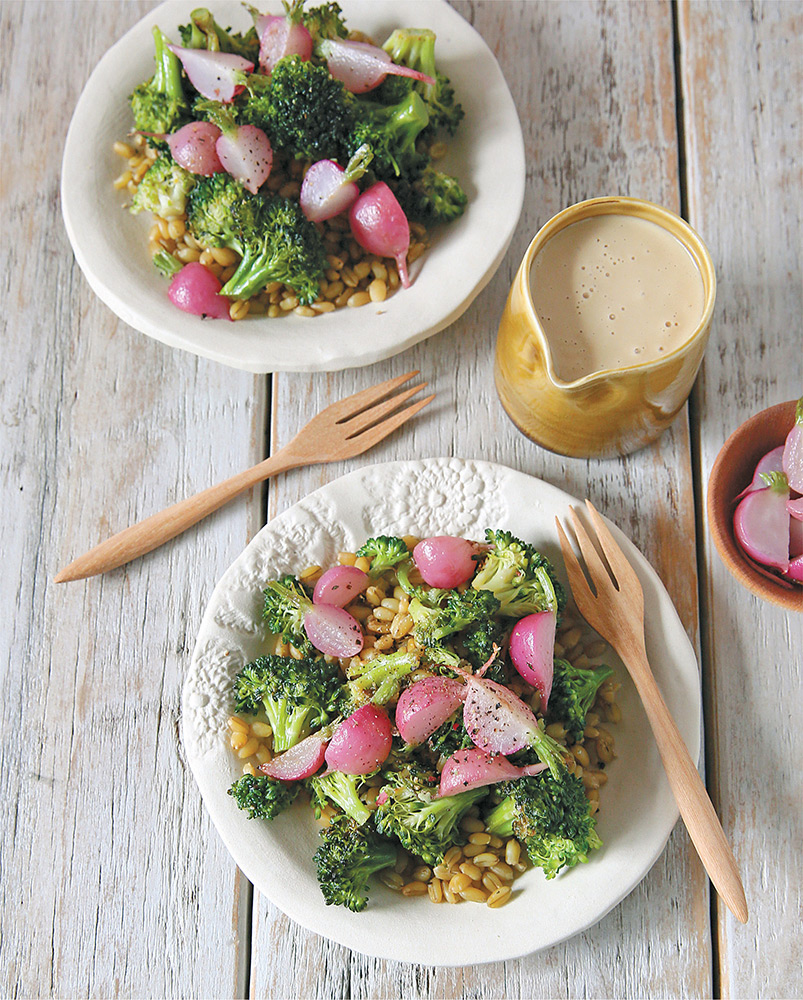
◁ Roasted Radish Freekeh Bowl with Mustard Miso Sauce
▸ GRAIN: FREEKEH
Radishes take on a special mellowness in this dish. When roasted alongside broccoli, you just know this will be as much of a feast for your taste buds as it is for your eyes. The oil-free sauce is rich and flavorful. If you have extra, it can be refrigerated airtight for 3 days and used as a salad dressing. Other grain options? Try barley, einkorn, farro, or cracked freekeh.
1/2 cup (90 g) dry whole freekeh
1 bunch (8 ounces, or 227 g) radishes, cleaned, cut into 1/2-inch (1.3 cm) cubes
2 1/2 cups (5 ounces, or 142 g) broccoli florets
1 tablespoon (15 ml) olive oil
Salt and pepper
1/3 cup (80 ml) vegetable broth
2 tablespoons (18 g) raw cashews
1 tablespoon (15 g) Dijon mustard
1 tablespoon (15 ml) apple cider vinegar
2 teaspoons (12 g) dark miso
1 teaspoon prepared horseradish
1 teaspoon pure maple syrup
Put the freekeh in a saucepan and cover with 4 inches (10 cm) of water. Bring to a boil, then cover, and reduce to simmer for 40 minutes or until tender. Set aside.
Heat the oven to 400°F (200°C, or gas mark 6). Combine the radishes, broccoli, and oil in a 9 × 13-inch (23 × 33 cm) pan. Season with salt and pepper. Roast for 30 minutes. When done, transfer to a medium-size bowl. Add the freekeh and stir to combine.
To make the sauce, combine the broth, cashews, mustard, vinegar, miso, horseradish, and maple syrup in a small high-powered blender. Process until smooth.
Divide the freekeh mixture between two plates. Drizzle with the sauce as desired.
YIELD: 2 servings, 2/3 cup (160 ml) sauce
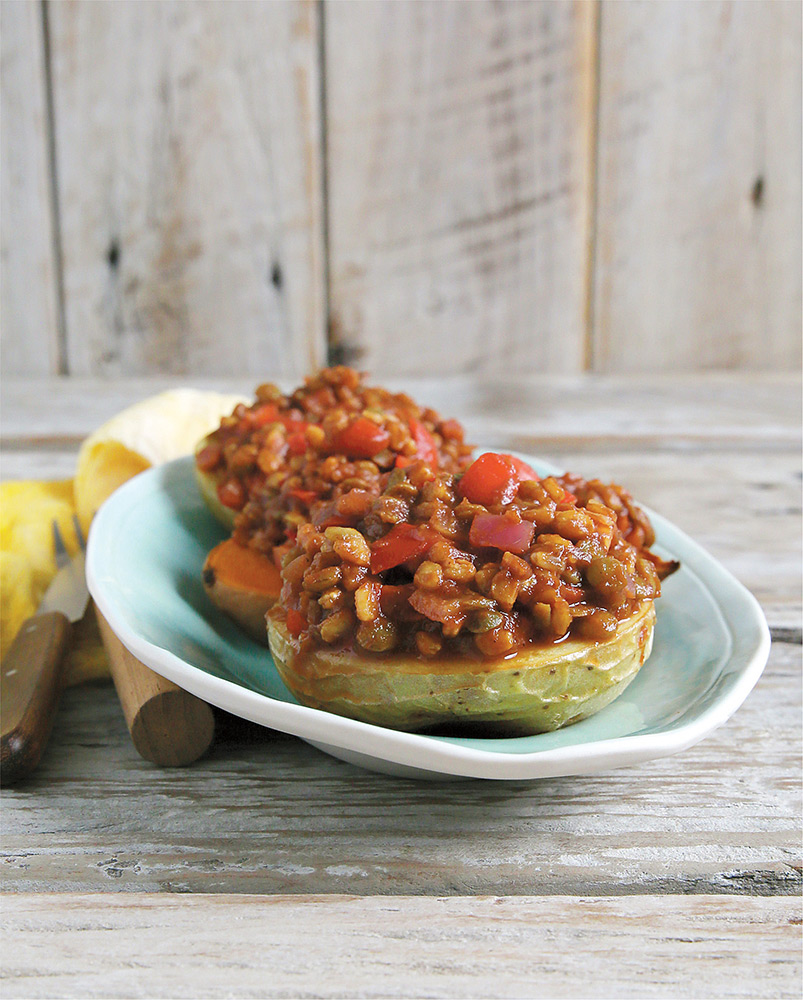
◁ Apple Butter Einkorn Sloppy Joes
▸ GRAIN: EINKORN
Hulled barley can be subbed for the einkorn if the latter is hard to find. Either grain will work wonderfully in this hearty, winter-style dish. Just be sure to adjust the cooking time accordingly (see pages 15–16). We personally love this most when piled high on baked regular or sweet potatoes. The fact that it is a fairly low-fat and high-fiber dish is an added bonus no one seems to mind.
1/3 cup (64 g) dry einkorn, rinsed and drained
1/3 cup (59 g) dry green lentils, rinsed and drained
1 tablespoon (8 g) Broth Powder (page 167)
1 teaspoon grapeseed or olive oil
3/4 cup (120 g) minced red onion
1 red bell pepper, seeded and diced
2 cloves garlic, minced
3/4 cup (180 g) unsweetened apple butter
1/2 cup (136 g) organic ketchup
1 teaspoon apple cider vinegar
1 teaspoon mild Dijon mustard
1 teaspoon vegan Worcestershire sauce
1 teaspoon liquid smoke
1/8 to 1/4 teaspoon cayenne pepper, to taste (optional)
1/2 teaspoon fine sea salt
Vegan buns, or baked potatoes (regular or sweet), or cooked greens, for serving
Place einkorn and lentils in a pot, cover with an extra 2 to 3 inches (5 to 7.5 cm) water and broth powder. Bring to a boil, partially cover with a lid, lower the heat to medium-low, and simmer until fully tender, about 35 minutes. Drain and set aside.
Place the oil, onion, bell pepper, and garlic in a skillet. Sauté on medium heat until the onion and pepper soften, about 6 minutes, stirring occasionally. In a small bowl, whisk to combine apple butter, ketchup, vinegar, mustard, Worcestershire sauce, liquid smoke, cayenne pepper, and salt. Add to the skillet, stirring to combine. Simmer uncovered for 15 minutes, stirring occasionally. Fold the cooked einkorn and lentils into the sauce, and simmer for another 5 minutes. Let stand 10 to 15 minutes before serving. Serve the traditional way inside buns, or go off the beaten path by serving on baked potatoes or on a bed of cooked greens.
YIELD: 6 to 8 servings
Rye Shakshuka
▸ GRAIN: RYE BERRIES
Rye berries bring great texture and thickness to this tomato-based dish that traditionally contains poached eggs. If rye berries aren’t available, use any grain with a similar texture, such as wheat berries, whole freekeh, or spelt, adjusting cooking time accordingly (see Grain Chart, pages 15–16).
1/2 cup (90 g) dry rye berries, rinsed and drained, cooked to al dente
1 1/2 tablespoons (23 ml) grapeseed or olive oil, divided
1 1/3 cups (200 g) chopped red bell pepper (about 2)
1/4 cup (40 g) minced shallot
1 generous tablespoon (12 g) minced garlic
2 teaspoons (4 g) dry harissa blend or harissa paste, to taste
1/2 teaspoon ground cumin
Couple pinches of salt, to taste
1 tablespoon (17 g) tomato paste
1 can (28 ounces, or 794 g) crushed plum tomatoes
12 ounces (340 g) super-firm cubed tofu or 1 1/2 cups (246 g) cooked chickpeas
1/4 teaspoon black salt (kala namak)
1/4 teaspoon smoked paprika
1/4 teaspoon ground turmeric
Vegan pita or lavash bread, for serving
Follow instructions in the grain chart to cook the rye berries. Set aside.
In a large skillet, place 1 tablespoon (15 ml) oil, bell pepper, shallot, garlic, and sauté on medium-high heat for 2 minutes. Add the spices, salt, and tomato paste. Sauté for 1 minute or until the pepper starts to soften. Add the tomatoes. Lower the heat and partially cover with a lid once the mixture gets bubbly. Simmer for 10 minutes, stirring occasionally.
Place the remaining 1 1/2 teaspoons oil in another skillet. Add the tofu cubes and sauté on medium-high heat until golden brown, about 8 minutes, stirring occasionally. Add black salt, paprika, and turmeric, and sauté 1 minute. If using chickpeas instead, sauté with spices for 4 minutes until heated through and fragrant.
Add the cooked rye to the shakshuka, stirring to combine, and partially cover with a lid. Simmer for 10 minutes, stirring occasionally. Remove the lid and place tofu or chickpeas evenly on top, without stirring. Cover and let stand 5 minutes with the stove turned off. Serve with bread.
YIELD: 6 servings
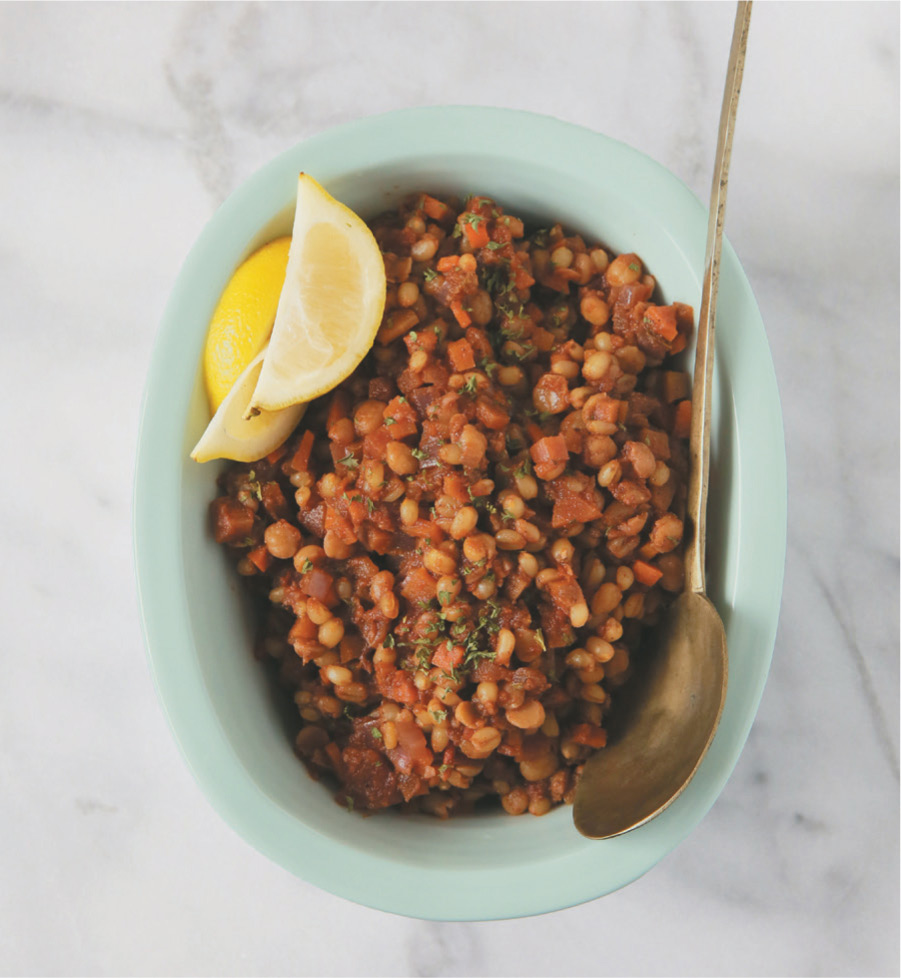
◁ Moroccan Wheat Berries
▸ GRAIN: WHEAT BERRIES ▸ SOY-FREE POTENTIAL
Don’t let the eclectic mix of spices scare you away from this delectable concoction! Sumac is a ground, Middle Eastern berry. If you haven’t tried it, you’ll be smitten with its tart, lemony flavor. Kamut, spelt, triticale berries, or any similar grain can be subbed for the wheat berries. Simply adjust cooking times accordingly.
1/2 cup (100 g) dry chana dal, rinsed and drained
2 1/2 tablespoons (20 g) Broth Powder (page 167), divided
1/4 cup plus 2 tablespoons (72 g) dry, soft, white wheat berries, rinsed and drained
1 3/4 cups (224 g) minced carrot
1 tablespoon (15 ml) melted coconut oil
1/2 cup (80 g) minced shallot or red onion
1/2 teaspoon fine sea salt, to taste
1 teaspoon ground coriander
1 teaspoon ground cumin
1/2 teaspoon ground sumac
1/4 teaspoon ground allspice
1/4 teaspoon ground nutmeg
1/4 teaspoon ground ginger
1/8 to 1/4 teaspoon cayenne pepper, to taste
1/8 teaspoon ground cinnamon
3 cloves garlic, grated or pressed (roasted is good here if handy)
1 to 2 teaspoons (2 to 4 g) dry harissa blend or paste, to taste
1 1/2 cups (240 g, or 1 large) diced tomato
Drizzle of fresh lemon juice, optional
Minced fresh mint, for garnish, optional
Place chana dal in a pot, cover with an extra 3 inches (7.5 cm) water and 1 tablespoon (8 g) broth powder. Bring to a boil, partially cover with a lid, lower the heat, and simmer until fully tender, about 1 hour. Drain if needed, and set aside.
At the same time, place the wheat berries in a pot, cover with an extra 3 inches (5 cm) water and 1 tablespoon (8 g) broth powder. Bring to a boil, partially cover with a lid, lower the heat, and simmer until tender, about 1 hour. Slowly and carefully drain by placing a fine-mesh sieve on top of a glass bowl or measuring cup to save the cooking liquid.
Cook carrots and shallot in oil on medium heat until softened, about 8 minutes. Stir occasionally. In the meantime, prepare the spice mix (salt through cinnamon) in a small bowl. Add spice mix, remaining 1 1/2 teaspoons broth powder, garlic, harissa, tomato, wheat berries, and chana dal to the skillet. Cover and cook on medium-low heat for 10 minutes to meld the flavors. Add reserved broth, if needed, or a drizzle of lemon juice. Turn off the heat, and let stand covered for 10 minutes before serving.
YIELD: 4 servings
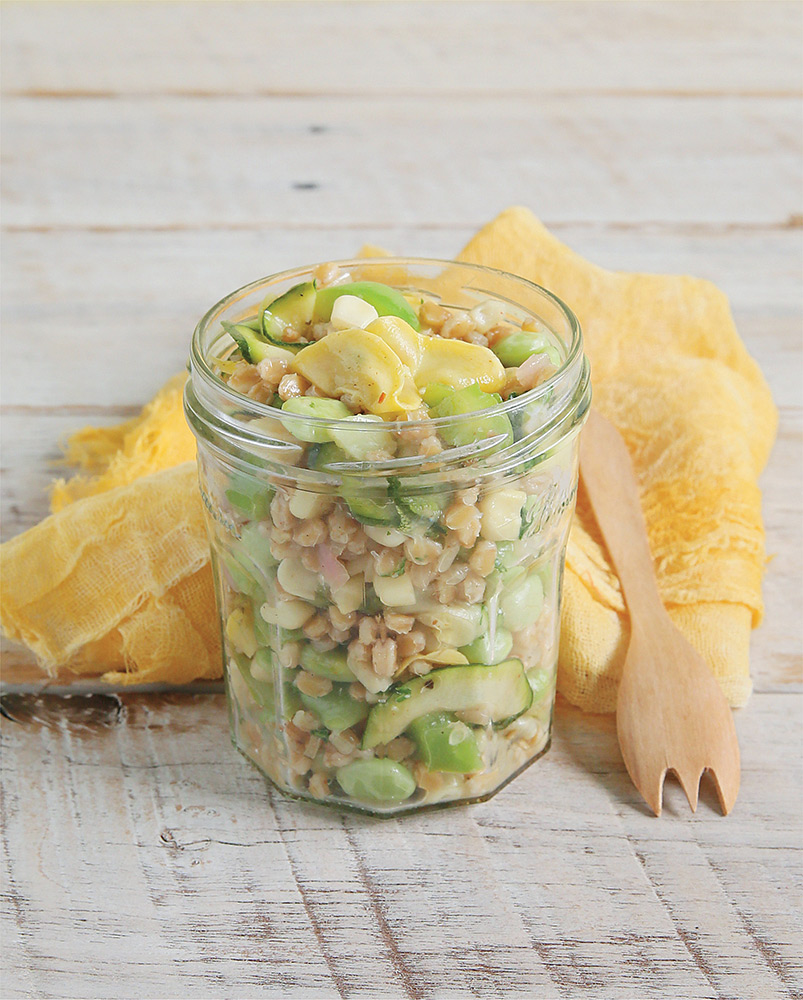
◁ Einkorn Succotash
▸ GRAIN: EINKORN ▸ SOY-FREE POTENTIAL
Succotash is a Native American dish composed of corn and lima beans, and its summery yellow and green colors are as appealing as its flavors! The einkorn can be replaced with the same amount of hulled barley or brown rice, if desired. Adjust cooking method and time according to the subbed grain. If you like spiciness, we highly recommend stirring some harissa, cayenne pepper, or any other favorite source of heat into each serving.
3/4 cup (144 g) dry einkorn, rinsed and drained
2 cups (470 ml) vegetable broth
1 1/2 teaspoons toasted sesame oil
1/2 cup (80 g) minced shallot
2 large cloves garlic, grated or pressed
1/2 green bell pepper, diced
1 cup (164 g) frozen baby lima beans, rinsed to thaw slightly
1 cup (164 g) frozen sweet white corn, rinsed to thaw slightly
Fine sea salt, to taste
Ground white peppercorn, to taste
3/4 cup (110 g) marinated yellow squash and zucchini (see Recipe Note), drained (optional)
Minced fresh parsley, to taste
Place the einkorn and broth in a medium saucepan. Bring to a boil. Lower the heat, cover with a lid, and simmer until al dente, 30 to 35 minutes. Drain, if needed, and set aside.
Place the oil, shallot, garlic, bell pepper, and lima beans in a large skillet. Cook on medium-high heat until just softened, about 4 minutes. Add the corn, salt, and pepper, and sauté another 2 minutes. Add the cooked einkorn, and cook on medium-low heat until heated through, about 4 minutes. Add the marinated veggies, and sauté another 4 minutes to let the flavors meld. Adjust seasoning, if needed. Garnish each serving with parsley.
YIELD: 4 servings
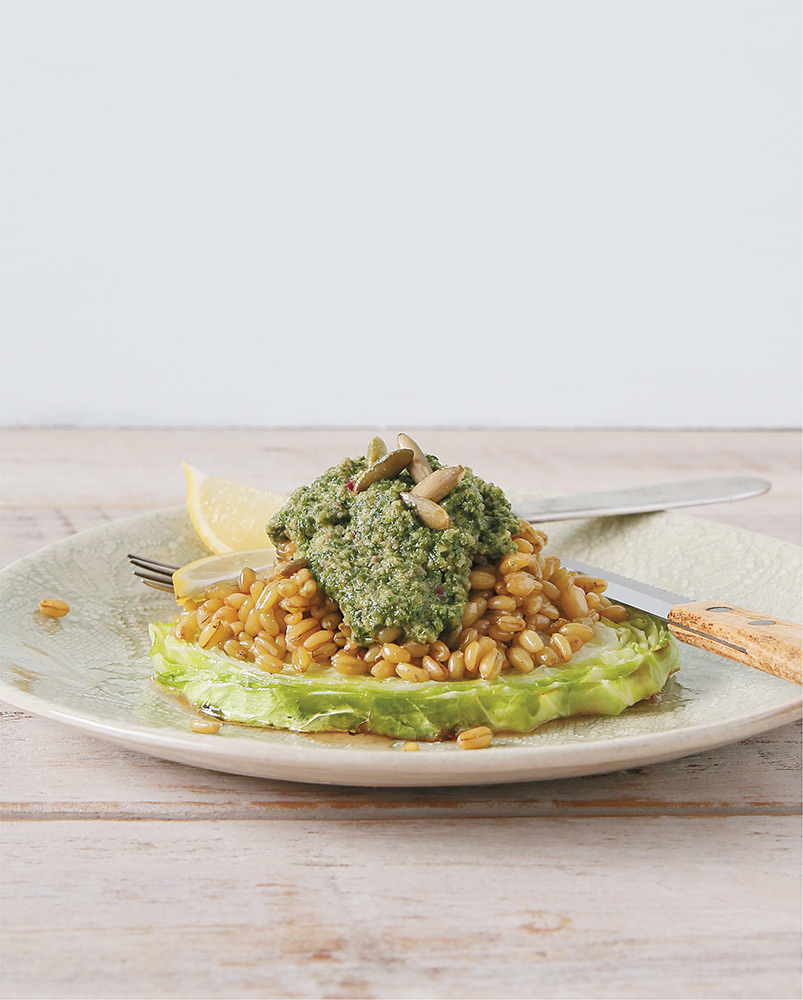
◁ Roasted Cabbage Steaks with Chimichurri Sauce
▸ GRAIN: FREEKEH ▸ SOY-FREE POTENTIAL
Chimichurri, an Argentinian green (or occasionally red) sauce, brings a wonderfully spicy edge to a simple freekeh recipe. The sweet, roasted cabbage completes this autumn meal. If you prefer, try cracked freekeh, einkorn, farro, or kamut instead of the whole freekeh, changing the cooking times to fit the grain.
FOR THE CHIMICHURRI SAUCE:
1 bunch (3 ounces, or 85 g) fresh parsley
1 large fresh cayenne pepper or other hot pepper
1 cup (160 g) chopped onion
4 to 6 cloves garlic
2 teaspoons (4 g) dried oregano
1 teaspoon fine sea salt
1/2 teaspoon ground black pepper
3 tablespoons (45 ml) white wine vinegar
2 teaspoons (10 ml) olive oil
FOR THE FREEKEH AND STEAKS:
1 cup (160 g) dry whole freekeh
4 slices (1/2-inch, or 1.3 cm) cabbage (see Recipe Note)
2 teaspoons (10 ml) olive oil
1/2 teaspoon smoked salt or garlic salt
Pinch of ground black pepper
To make the chimichurri sauce: Put the parsley, hot pepper, onion, garlic, oregano, salt, and pepper into a food processor. Add the vinegar and the olive oil. Process to combine.
To make the freekeh and steaks: Put the freekeh in a saucepan and cover with 4 inches (10 cm) water. Bring to a boil, then cover, and reduce to simmer for 40 minutes or until tender. Heat the oven to 400°F (200°C, or gas mark 6). Put the cabbage slices on a large, oiled baking sheet. Using your fingers, spread 1/2 teaspoon of oil on each slice. Sprinkle evenly with the salt and pepper. Bake for 30 minutes. If some of the outer edges of the leaves brown, carefully cut them off.
To serve, put a slice of cabbage on each plate. Top with one-quarter of the freekeh and drizzle with the chimichurri sauce to taste.
YIELD: 4 servings, 1/4 cup (60 ml) chimichurri sauce
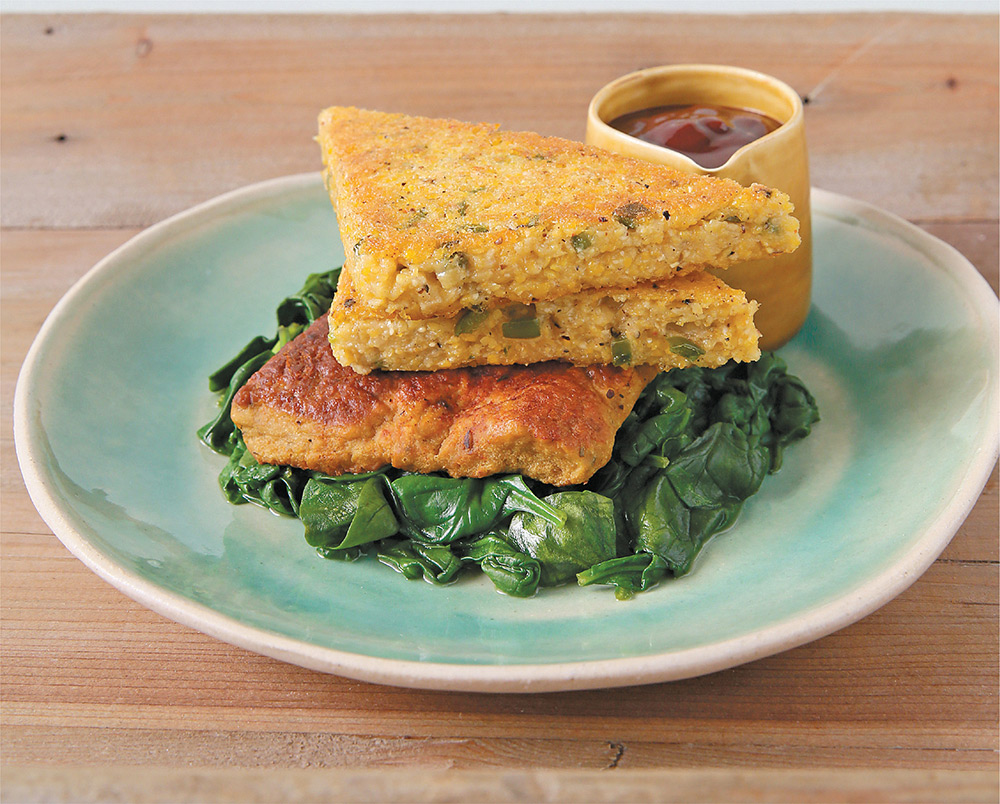
◁ Pepper Lovers’ Polenta with Raspberry BBQ Seitan
▸ GRAIN: POLENTA ▸ SOY-FREE POTENTIAL
Our supereasy raspberry BBQ sauce brings out all the flavor of the crispy polenta triangles and makes for a hearty meal. This polenta is mildly spiced as written, but rev up your engines and double the peppers, if you’ve got the nerve. Try it this way once, then go for the spice!
FOR THE POLENTA:
1 1/2 cups (355 ml) water
1/2 cup (70 g) dry polenta
1 tablespoon (9 g) minced jalapeño pepper
1 teaspoon minced habañero pepper, more to taste
1/2 teaspoon onion powder
1/2 teaspoon fine sea salt
Ground black pepper
High heat neutral-flavored oil, for cooking
FOR THE SEITAN AND SAUCE:
3/4 cup (95 g) fresh raspberries
1/4 teaspoon ground allspice, plus a pinch
1/4 teaspoon cayenne pepper
1/4 teaspoon dried thyme
1/2 cup (125 g) prepared barbecue sauce
2 (4 ounces, or 113 g each) Quit-the-Cluck Seitan cutlets (page 169)
1/4 teaspoon paprika
5 ounces (142 g) baby spinach
Salt and pepper
High heat neutral-flavored oil, for cooking
To make the polenta: Line a loaf pan with parchment paper, being sure to reach about 2 inches (5 cm) up the sides.
Bring the water to a boil in a medium-size saucepan over high heat. Whisk in the polenta, hot peppers, onion powder, salt, and a generous pinch of ground black pepper. Reduce the heat to simmer. Continue whisking for 5 to 10 minutes until the mixture is thick and clears the bottom of the pan. Pour into the prepared loaf pan and let cool for 30 minutes. Refrigerate for a minimum of 2 hours so the polenta is very firm. At this stage, if wrapped airtight and refrigerated, the polenta can be stored for up to 1 week.
To cook the polenta, lift the parchment paper carefully from the loaf pan. The polenta will be in a loaf-shaped plank. Cut the polenta in half vertically, then cut each half diagonally to create 4 triangles. Pour a 1/4-inch (6 mm) layer of oil in a large skillet and heat over medium heat. Add the triangles and do not move them until the bottom is slightly browned, about 4 to 6 minutes. Moving them too soon can remove the crisp outer coating. Turn over the triangles, and cook the second side until browned and crisp, about 4 to 6 minutes. Serve hot.
To make the seitan and sauce: Rub the paprika and remaining pinch of allspice into one side of each cutlet. Sprinkle with salt and pepper. Oil a grill pan and heat over medium-high heat. Put the cutlets in the pan and cook until marked, 4 to 5 minutes. Turn over to cook the second side for 4 to 5 minutes or until marked.
For the sauce, purée the raspberries and pour into a small saucepan. Add 1/4 teaspoon allspice, cayenne pepper, thyme, and the barbecue sauce. Stir to combine. Heat gently over low heat, then set aside until serving. Reheat, if needed.
To serve, heat a large skillet over medium heat. Quickly cook the spinach until barely wilted. Divide the spinach evenly between two plates. Top each with a seitan cutlet and 2 polenta triangles. Top with the barbecue sauce, as desired.
YIELD: 2 servings
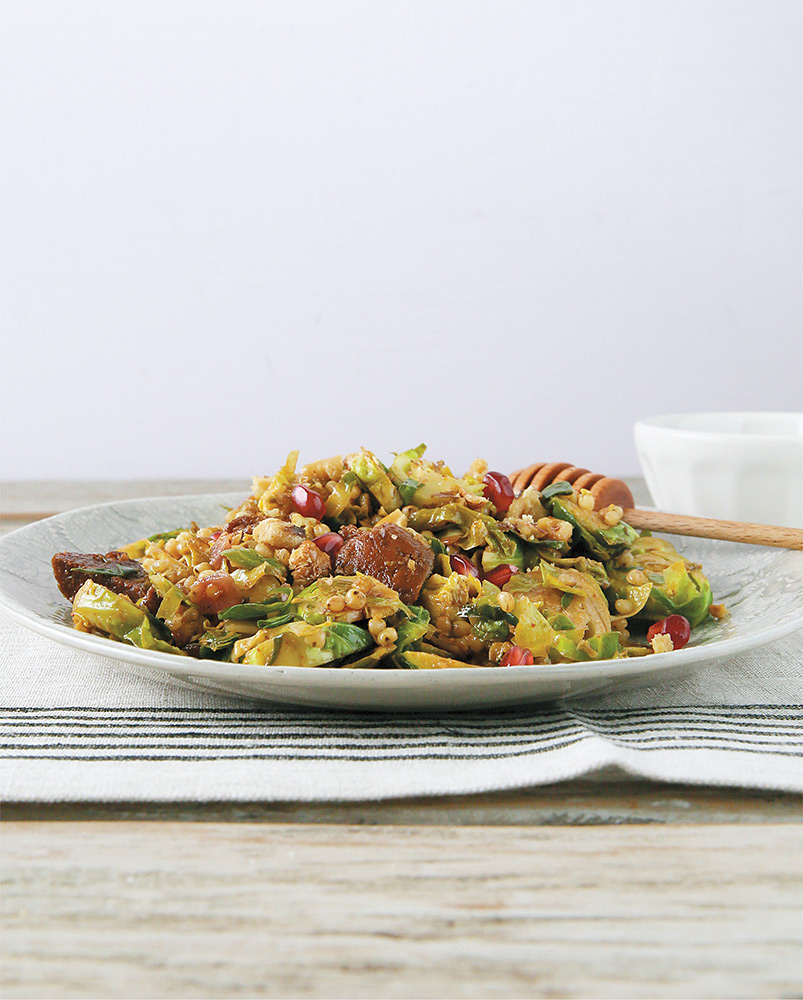
◁ Muhammara Redux with Sorghum
▸ GRAIN: SORGHUM ▸ SOY-FREE POTENTIAL ▸ QUICK AND EASY
Muhammara is a Middle Eastern red pepper dip, composed of walnuts, pomegranate molasses, bread crumbs, and more. We’ve deconstructed the dish here using pepper-based sausages and substituting whole grains for bread crumbs. While the (delicious) resulting flavor isn’t entirely muhammara-like, it is a looker of a dish that can be ready relatively quickly, provided the sausages and grain were cooked ahead of time.
1 tablespoon (15 ml) olive oil, divided
2 Pepper Grain Sausages (page 87), cut into slanted, bite-size half-moons
1 tablespoon (15 ml) pomegranate molasses (see Recipe Note), plus extra for garnish
1/4 cup (40 g) chopped shallot or red onion
10 ounces (283 g) shaved brussels sprouts
2 cloves garlic, grated or pressed
1 teaspoon dry harissa blend or paste, to taste
1/2 teaspoon ground cumin
1/4 cup (60 ml) vegetable broth
Salt and pepper
Scant 1 1/2 cups (225 g) cooked sorghum or other grain
Toasted walnuts halves, for garnish
Pomegranate seeds (arils), for garnish, optional
Fresh mint leaves or parsley, for garnish, optional
In a large skillet, heat 1 1/2 teaspoons of oil on medium-high heat. Add the sausage pieces, and sauté until browned, stirring occasionally, about 6 minutes. Pour the molasses on top, and cook 1 minute to glaze. Transfer to a plate and set aside.
In the same skillet, place the remaining 1 1/2 teaspoons of oil and shallot and sauté on medium-high heat until translucent, about 2 minutes. Add the sprouts, and sauté for another 5 minutes, until lightly browned. Add the garlic, harissa, cumin, and broth, cover with a lid, and simmer until tender, about 5 minutes. Stir the sorghum and sausage into the sprouts, and cook uncovered until heated through, about 2 minutes. Top each serving with walnuts, pomegranate seeds, and herb of choice. Drizzle a little extra molasses on top, if desired.
YIELD: 2 to 3 servings
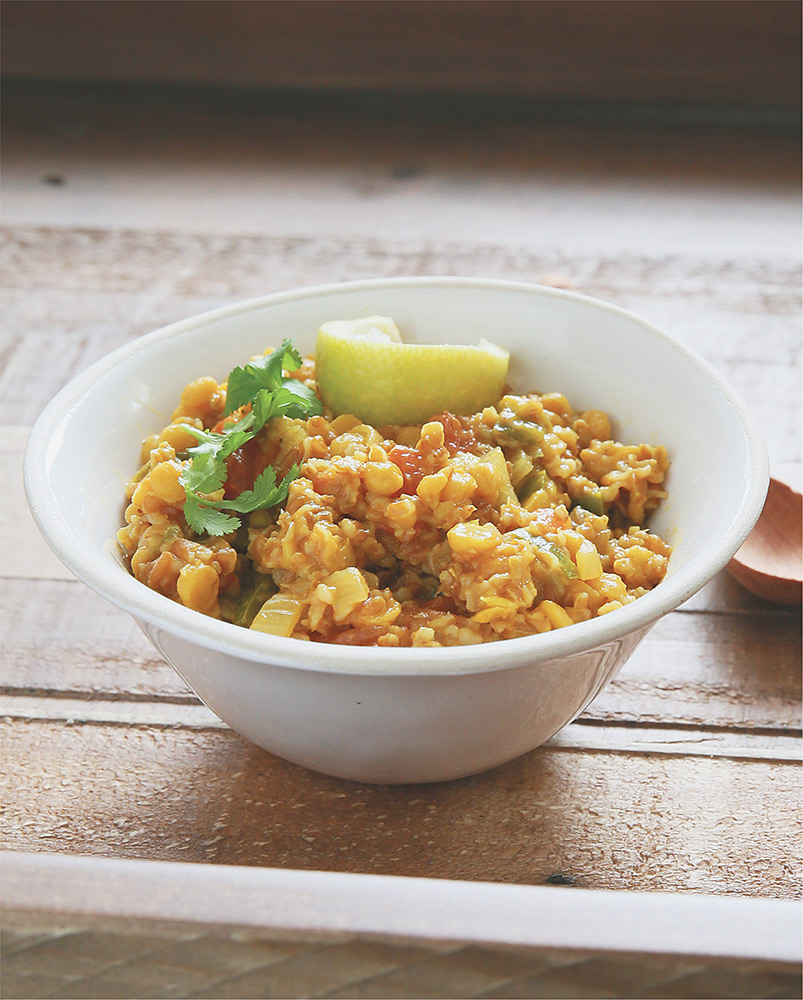
◁ Chana Dal Dalia
▸ GRAIN: CRACKED WHEAT ▸ SOY-FREE POTENTIAL
Dalia is a Hindi term that refers to broken grains. It is also a porridge-like dish that is frequently served in India when illness strikes, due to its nutritional benefits as well as its blandness. We’ve broken tradition (and grain!) here by making things a bit more flavor rich, a little less porridge-like, and by using chana dal (split baby chickpeas) alongside cracked wheat. Serve with roasted broccoli and chapati bread.
3 cups (705 ml) water, divided
1/2 cup (100 g) dry chana dal (split baby chickpeas), rinsed and drained
1 1/2 teaspoons melted coconut oil
1/4 cup (40 g) chopped shallot
2 large cloves garlic, minced
1 1/2 teaspoons grated ginger
1 small jalapeño pepper, seeded and minced
1 teaspoon ground cumin
1/2 teaspoon turmeric
1/2 teaspoon coarse kosher salt, more to taste
2 Roma tomatoes, seeded if desired, diced
1/2 cup (80 g) dry cracked wheat, roasted (see Recipe Note)
1/2 cup (8 g) chopped fresh cilantro leaves, for garnish
Combine 1 1/2 cups (355 ml) water with chana dal in a medium pot. Bring to a boil, lower the heat, cover with a lid, and precook for 25 minutes until partially tender. (For an almost mushy Chana Dal Dalia, extend the precooking time to tender, about 30 to 35 minutes.) Drain, if needed. Set aside.
In a skillet, heat the oil on medium. Add the shallot, garlic, ginger, and jalapeño. Sauté until softened and fragrant, about 3 minutes. Add the cumin, turmeric, salt, and tomatoes, and sauté another minute. Add the roasted wheat, precooked chana dal, and remaining 1 1/2 cups (355 ml) water, stirring to combine. Cover with a lid and cook until the water is absorbed and the wheat and chana dal are fully tender, about 30 to 35 minutes. Add extra liquid and cook longer, if needed.
Let stand 10 minutes before serving. Serve topped with cilantro. Leftovers can be stored in an airtight container in the refrigerator for up to 4 days.
YIELD: 4 servings
Saucy Peanut Eggplant and Freekeh
▸ GRAIN: FREEKEH (WHOLE) ▸ SOY-FREE POTENTIAL
We find that this easy, comforting meal is really good served on top of any type of sturdy grain. If you cannot find freekeh, use kamut, wheat berries, sorghum, or even brown rice (as gluten-free potential options), or any similar grain you love the most! Just remember to adjust cooking liquid amounts and cooking times accordingly. We should mention we rarely peel eggplant but if the skin bothers you, don’t hesitate to remove it.
1 cup (160 g) dry whole freekeh, rinsed and drained
3 1/2 cups (825 ml) water, divided, more if needed
2 tablespoons (16 g) Broth Powder (page 167), divided
1/2 cup plus 2 tablespoons (100 g) chopped shallot
1 eggplant, trimmed and cut into bite-size pieces
1 tablespoon (15 ml) fresh lime juice
Generous 1/4 teaspoon fine sea salt, to taste
1 1/2 tablespoons (15 g) minced garlic
1 1/2 teaspoons grated fresh ginger, or scant 1/2 teaspoon ground ginger
1 to 2 teaspoons (2 to 4 g) dry harissa blend or paste, to taste
1 teaspoon ground cumin
1/3 cup (85 g) natural crunchy peanut butter
3 tablespoons (48 g) tomato paste
Fresh cilantro or parsley, for garnish
Place the freekeh, 2 1/2 cups (590 ml) water, and 1 tablespoon (8 g) broth powder in a large pot. Bring to a boil. Lower the heat, cover with a lid, and simmer until tender, about 40 minutes. Drain, if needed, and set aside.
While the freekeh is cooking, place the shallot, eggplant, remaining 1 tablespoon (8 g) broth powder, lime juice, and salt in a large skillet. Cook on medium heat until browned, stirring frequently, about 8 minutes. If the eggplant sticks to the pan, add water or broth as needed, 1 tablespoon (15 ml) at a time.
In a medium bowl, whisk to combine the garlic, ginger, harissa, cumin, 3/4 cup (180 ml) water, peanut butter, and tomato paste. Add this mixture to the eggplant. Bring to a gentle boil. Lower the heat again, cover with a lid, and simmer until the eggplant is just tender, but not mushy, about 15 to 20 minutes. The timing will depend on the freshness and size of the eggplant cubes, so be sure to check and stir occasionally to see if you need to add the remaining 1/4 cup (60 ml) water to obtain the desired saucy texture. Adjust seasoning, if needed. Serve the freekeh with the eggplant preparation on top. Garnish with cilantro.
YIELD: 4 servings
Hearty Sweet Potato and Sorghum Curry
▸ GRAIN: SORGHUM ▸ SOY-FREE POTENTIAL ▸ GLUTEN-FREE POTENTIAL
We love to serve this dish with a side of leafy greens for a deliciously filling meal. If you prefer, you can also directly wilt 1 1/2 cups (weight will vary) packed, finely minced greens in the curried mixture during the last 5 minutes of cooking.
1 cup (204 g) dry sorghum, soaked overnight, rinsed and drained
1 1/4 cups (200 g) chopped yellow onion
21 ounces (595 g) chopped sweet potato (bite-size pieces, about 4 medium potatoes)
4 cloves garlic, minced
2 tablespoons (30 ml) fresh lime juice
1 tablespoon (6 g) mild or medium curry powder
1 tablespoon (8 g) Broth Powder (page 167)
1/2 teaspoon ground coriander
1/2 teaspoon dry harissa blend or paste, more to taste
1/2 teaspoon fine sea salt, to taste
1/4 teaspoon ground ginger
1/4 teaspoon ground cumin
1 can (14 ounces, or 414 ml) full-fat coconut milk
Fresh cilantro leaves, for garnish
Place the soaked sorghum in a large pot, and cover with about 2 to 3 inches (5 to 7.5 cm) of water or vegetable broth. Bring to a boil, and cook until thoroughly tender (sorghum should not remain chewy like kamut or wheat berries), about 1 hour. Drain, and set aside.
In the meantime, cook the sweet potatoes: In a large skillet, place the onion, sweet potato, garlic, lime juice, curry powder, broth powder, coriander, harissa, salt, ginger, and cumin. Cook on medium heat until the onion and sweet potato soften slightly, about 8 minutes. Stir occasionally. If the potatoes stick to the skillet, add water, 1 tablespoon (15 ml) at a time. Add the coconut milk, bring to a gentle boil, lower the heat, and cover with a lid. Simmer until the sweet potatoes are fork tender, about 25 minutes. Cooking time depends on the size of the potato pieces, so check and stir occasionally. Adjust seasoning, if needed, adding extra harissa if you like spice. Serve on a portion of sorghum, topped with cilantro, and alongside greens.
YIELD: 4 to 6 servings
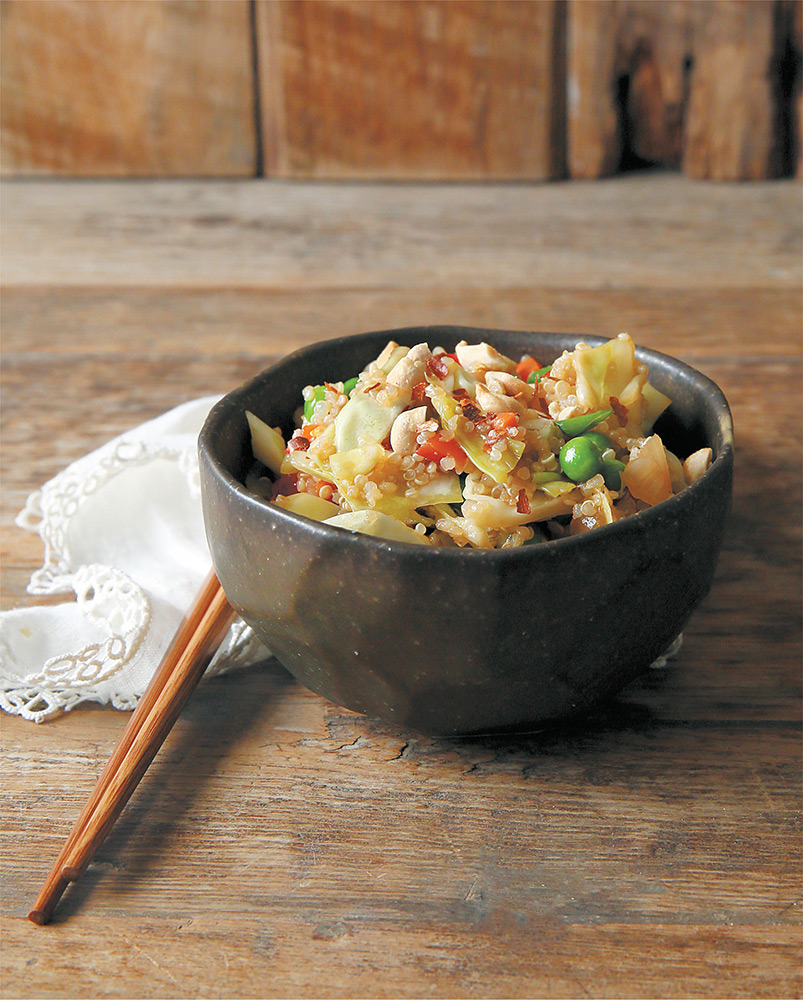
◁ Quinoa and Veggies Stir-Fry
▸ GRAIN: QUINOA ▸ QUICK AND EASY ▸ GLUTEN-FREE POTENTIAL
Rice is nice, but how about a complete protein in the form of quinoa for a change, instead? This straightforward, scrumptious version gets our (and the testers’) vote. Note that the quinoa absolutely needs to be cooked ahead and chilled in order to avoid mushy results.
1 tablespoon (15 ml) peanut, coconut, or other oil
2 small carrots, trimmed, peeled, and minced
1/4 cup plus 2 1/2 tablespoons (65 g) minced shallot
2 1/2 cups (227 g) chopped green cabbage
1 small bell pepper (any color), seeded and diced
1 1/2 tablespoons (15 g) minced garlic
2 tablespoons (30 ml) tamari, divided
1 3/4 cups (324 g) cooked and chilled quinoa
2 teaspoons to 1 tablespoon (10 to 15 ml) toasted sesame oil, as needed
1 cup (134 g) frozen green peas, thawed
Red pepper flakes or sriracha, to taste
GARNISHES:
White and green parts of scallion cut diagonally, toasted sesame seeds, pickled daikon radish, pickled ginger, chopped dry roasted peanuts or cashews, ume plum vinegar, to taste, for garnish
Place the oil, carrots, and shallot in a wok or large skillet. Sauté on medium-high heat until just softened, about 4 minutes, stirring occasionally. Add 1 tablespoon (15 ml) tamari, cabbage and bell pepper, and cook until slightly tender yet still crisp, about 4 minutes, stirring occasionally. Drizzle sesame oil as needed over the quinoa, and fold to lightly coat. Add the quinoa to the wok, remaining 1 tablespoon (15 ml) tamari, and peas. Sauté for another 2 minutes, stirring occasionally, until heated through and fragrant.
Remove from the heat, add red pepper flakes or sriracha. Choose one or more garnishes to taste. Serve immediately as is or alongside your favorite recipes of Asian-style seitan, tofu, tempeh, or beans.
YIELD: 4 servings
Kasha Varnishkes
▸ GRAIN: BUCKWHEAT ▸ SOY-FREE POTENTIAL
This hearty, comfort food dish is part of the Jewish tradition. While we won’t claim that ours is authentic, it’s still become a favorite. Kasha is the name given to buckwheat groats when they have been toasted. Farfalle pasta is sometimes referred to as bowtie pasta. But in fact, “farfalle” means butterflies. Call it what you will, this is stick-to-your-ribs happy food.
2 tablespoons (30 ml) olive oil, divided
3/4 cup (120 g) chopped onion
1 1/2 cups (5 ounces, or 140 g) sliced cremini mushrooms
1/2 cup (92 g) buckwheat, toasted (see Recipe Note)
2 tablespoons (30 ml) dry white wine, or additional broth
2 large cloves garlic, minced
1 1/2 cups (355 ml) boiling water
1 tablespoon (18 g) vegan bouillon paste
1 teaspoon poultry seasoning blend
4 ounces (113 g) dry farfalle pasta (whole-grain or white), cooked and drained
5 ounces (140 g) baby spinach
Salt and pepper
Minced fresh dill, for garnish
Heat 1 tablespoon (15 ml) oil in a large skillet over medium heat. Cook the onions for 6 to 8 minutes, stirring occasionally, until tender and golden. Transfer to a plate and set aside. Add the mushrooms to the same skillet and cook until tender, 3 to 4 minutes. Transfer to the same plate as the onions, but do not mix the two. Add the remaining tablespoon (15 ml) olive oil to the skillet and add the buckwheat. Cook, stirring occasionally, until the buckwheat is covered with oil. Add the onions, wine, and garlic to the skillet. Cook until the wine is mostly absorbed.
Combine the boiling water, the bouillon paste, and the seasoning blend. Pour 1 cup (235 ml) of the broth into the skillet and cook for 20 to 30 minutes, stirring occasionally. Cook until the buckwheat is tender. Add the mushrooms, pasta, spinach, and splashes of the remaining broth until the spinach wilts and the mixture is hot throughout. Season to taste with salt and pepper. Garnish with the dill when serving.
YIELD: 4 generous servings